DEUSCHLE (or DEUSCHLER), JACOB (1834-1877). Wagoner, 39th New York Infantry, Company C; private, 3rd New York Infantry, Company K. Born in Würremburg, Germany, he immigrated to the United States in 1853. He enlisted as a private at New York City on May 12, 1861, and mustered into the 39th New York, also known as the Garibaldi Guard, on May 28. Promoted to wagoner during his service, he was wounded on May 6, 1864, at the Battle of the Wilderness, Virginia, and was discharged on June 24, 1864. After re-enlisting as a private at the 11th Congressional District in New York on March 11, 1865, he mustered into the 3rd that day and mustered out on August 28, 1865, at Raleigh, North Carolina. A butcher in civilian life, he last resided at 161 Rivington Street in Manhattan. His death was caused by phthisis. Section 115, lot 13536 (Soldiers’ Lot), grave 123.
Civil War Bio Search
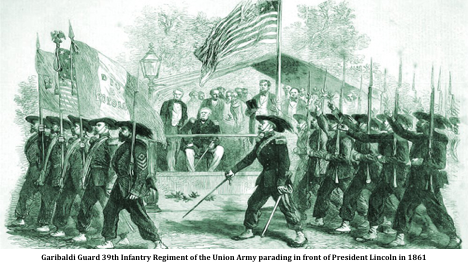
DEVALL, FRANCIS D. (1835-1869). Second lieutenant, 80th New York Infantry, Company I; private, 20th Regiment, New York State Militia, Company D. Born in Woodstock, New York, he was employed as a farmer, carpenter and machinist. After enlisting at Kingston, New York, as a private on April 23, 1861, he mustered into the 20th New York State Militia on May 11, and mustered out on August 2 after serving three months. The next month, he re-enlisted as a sergeant at Kingston on September 23, mustered into the 80th New York, was promoted to first sergeant on November 1, 1862, rose to second lieutenant on March 4, 1863, and was discharged on September 22, 1864. After suffering a business-related accident on March 3, 1869, his arm was amputated and he died of pyaemia on March 24 at Bellevue Hospital in Manhattan. He was re-interred at Green-Wood on November 28, 1869. Section 184, lot 19135.
DEVLIN, DANIEL (1829-1878). Private, 42nd New York Infantry, Company A. Devlin enlisted as a private, mustering into the 42nd New York. He was wounded on October 21, 1861, at Ball’s Bluff, Virginia. On April 8, 1862, he was discharged for disability. The 1875-1876 New York City Directory lists him as a barkeeper living at 504 West 30th Street, his last address. His death was caused by phthisis pulmonalis. Section B, lot 9895, grave 332.
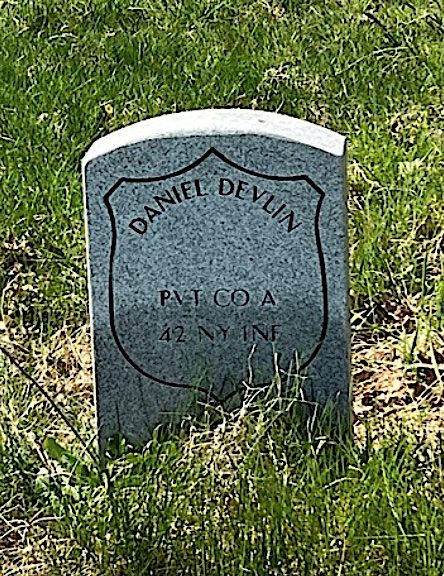
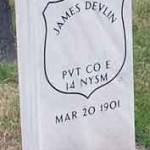
DEVLIN (or DEVAIN), JAMES (1838-1901). Private, 84th New York (14th Brooklyn) Infantry, Company E. Devlin was a Brooklynite by birth. Serving for less than a month in 1861, he enlisted at Brooklyn on April 18, mustered into the 14th on May 23, and was discharged for disability on June 9. In 1882, he applied for an invalid pension, application 454,259, but no certificate number is listed. As per the Brooklyn Directory for 1891, he was a plumber. His last residence was 50 Navy Street, Brooklyn. Devlin died of pneumonia. Catherine M. Devlin, who is interred with him, applied for a widow’s pension in 1909, application 926,428, but there is no evidence that it was certified. Section 14, lot 4969, grave 311.
De VOURSNEY, ABRAM P. (1827-1911). Officer, Metropolitan Police Force, New York City Draft Riots. A New Yorker by birth, he is listed as a policeman on the census of 1860. During the New York City Draft Riots in July 1863, De Voursney was in command at Frankfort Square and Spruce Street in Manhattan, near City Hall, on July 13. According to The Metropolitan Police, Their Services During Riot Week, Their Honorable Record by David M. Barnes (1863), there were rumors that the rioters were assembling uptown and were ready to return to Frankfort Square. When the mob reassembled, De Voursney addressed them, using every argument to urge them to retire, but when they did not, he ordered, “Now, men, go in and give it to them!” The report went on to say, “Go in they did, forthwith, and where moral suasion failed, the locusts [wooden nightsticks] succeeded. It was a quick and severe fight, and a number were so badly punished as to be unable to get away. This was the last serious demonstration in that section, the determined action and success of the police furnishing a lesson which was laid to heart.” Later, De Voursney was on his own when the mob broke into the New York Tribune building. The rioters at that site had been chanting, “We’ll hang Old Greeley on a sour-apple tree.”:
“…Sergeant De Voursney was in the crowd alone and edging his way to the Tribune office just before the mob broke into it; he had got on to the sidewalk, and drawing his revolver was about to shoot the man cheering on the crowd, and who was also engaged in breaking in the door; several bold and good citizens were there, endeavoring to dissuade the rioters from their work, and they crowded around the Sergeant, one of them seizing his arm and begging him to desist, that he would do no good, would sacrifice his own life, besides exciting the crowd to a frenzy; heeding the wise advice he forced his way back, got to the station, found Capt. Thorne had been telegraphed to, hurried back, heard the cheer of the gallant force on its charge from Nassau, went in with his locust and fought his way through and to them, joining in the general fight. When it is remembered that the Sergeant was in uniform, his conduct exhibits the truest courage.”
Many policemen were injured in the ensuing melee; they were taken to the 26th Precinct station-house where Police Surgeon Kennedy and two assistants dressed their wounds. On July 14, with De Voursney in command, he and three other police sergeants toured the 10th and 13th Wards. Subsequently, the force, under Inspector George W. Dilks (see), marched to the station-house on First Avenue and 22nd Street. At that time, many of the dispersed mob, who had taken shelter in the nearby buildings, subjected the police to heavy fire from the roofs, windows and doors. The military were called in to support the police, who had no weapons to retaliate, and quell the mob. The report goes on to say that De Voursney’s head was grazed by a bullet; a sergeant from another precinct loaded his musket and discharged it with careful aim. During a most difficult day, De Voursney was stoned by the gangs, subjected to verbal abuse when women shouted that the police “would all be killed like rats before they left the ward,” and fellow police were accidentally shot by the militia when the Gibbons’ house at 19 Lamartine Place was sacked. The men of the 26th Precinct returned to the City Hall area from July 15-July 17, 1863, where they were actively involved in scouting expeditions.
At some point during his career, De Voursney rose to police captain. He last lived in Montclair, New Jersey. As per his obituary in the New York Herald, he died at the Mountainside Hospital in Montclair from disease. His courageous actions during the New York City Draft Riots that are discussed above are detailed in an extensive feature article that appeared in the New York Herald on November 24, 1912, a time when the corrupt actions of a few police officers were in the news; that article was entitled, Upholding Traditions of the Force—New York Policemen Face Certain Death in Discharge of Duty. Section 116, lot 10213.
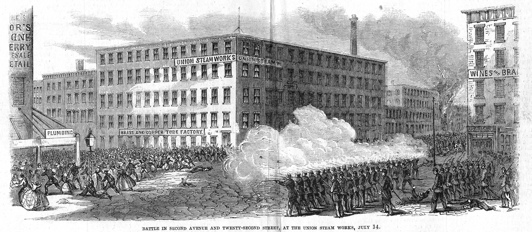

DEWEY, GEORGE EUGENE (1843-1922). Private, 145th Ohio Infantry, Company B. Born in Fort Wayne, Indiana, his father, a grape grower and wine merchant, planted the first vineyard in Northern Ohio in the 1850s. During the Civil War, George Dewey enlisted as a private on May 2, 1864, and mustered into the 145th Ohio on May 12. He mustered out on August 24, 1864, at Camp Chase, Ohio. His family settled in Brooklyn in 1866.
As per his obituary in The New York Times, he was a wine merchant in New York City for more than 50 years whose establishment bore the name H. T. Dewey and Sons, a business founded by Hiram T. Dewey, George’s father. According to his 1895 passport application, he was 5′ 7″ tall with gray hair, blue eyes, a straight nose and fair complexion. Frances Amelia Cameron Dewey, his wife, died in 1889; they had four children, two of whom died as infants. On March 12, 1904, an article in the New York Herald, “Churches Open to Wine Dealers,” discussed the opinions of various clergymen on the admission of Dewey, a wine merchant, into the Lewis Avenue Congregational Church. A controversial issue in its day, most of the clergy agreed that the church should consider a person’s character and the life one lived as more meaningful than one’s occupation.
In 1906, he applied for and received a pension, certificate 1,133,903. In 1900, the family’s wine company exhibited and was awarded a bronze medal for American wines at the Paris Exposition; the company’s address was 138 Fulton Street in New York City. Upon his father’s death, George Dewey became president of the company in 1901. The 1907 World Almanac noted that H. T. Dewey & Co. owned the largest wine cellars near Egg Harbor, New Jersey, that state’s grape region.
An article in the Brooklyn Daily Eagle on March 23, 1910, discussed the initiation of Dewey, his three sons (two with his second wife) and nephew as third degree Masons. At the ceremony, Dewey wore the ritual apron, once worn by his great-grandfather, a Master Mason, who fought in the American Revolution in Poultney, Vermont. It was noted in the piece that he was commander of the John Adams Dix Post #135 of the G.A.R. and had been a senior vice department commander of the New York State G.A.R. On the same night as his initiation, he was elected, in absentia, grand marshal of Manhattan and the Bronx by the Memorial and Executive Committee of the G.A.R. In 1914, Dewey led tributes on Memorial Day at the grave of John. A. Dix; he had been commander of the G.A.R. Post that honored Dix for 10 years.
Dewey’s winery was noted for its advertising publications. In 1917, a 36-page catalog, H. T. Dewey & Sons Co. Wine, was distributed that included advertisements for Dewey brand wines, ordering instructions, history of the company, medicinal uses of wine and excerpts from reviews about Dewey’s vintages. In 1918, their 12-page catalog was entitled, H. T. Dewey & Sons Co. Pioneer American Wine House.
As per his obituary in the Brooklyn Standard Union, which confirms Dewey’s Civil War service, he was a member of the New York Society of the Order of Founders and Patriots of America, the Sons of the Revolution, and the Society of the War of 1812. His obituary in the New York Tribune also validates his Civil War service and membership in military associations. His last residence was 651 Putnam Avenue, Brooklyn. He was survived by three sons and a daughter. In 1967, Dewey’s grandson, Eugene Stapleford Dewey, applied for membership in the Sons of the American Revolution, tracing his lineage back to Jeremiah Dewey of Vermont. Section 155, lot 25026.
DEWITT, THEODORE (1821-1881). First lieutenant and quartermaster, 119th New York Infantry. A native New Yorker, he was the son of a prominent lawyer and was a merchant living in Yonkers, New York, as per the census of 1860. He enlisted as a first lieutenant at Weaversville, Maryland, on June 23, 1863, was commissioned into the 119th New York two months later on August 24, and was discharged for disability on November 8, 1864. He also served as a quartermaster in his regiment. As per the 1870 census, he was a retired merchant who still resided in Yonkers; the 1880 census notes that he suffered from chronic rheumatism. He last lived in Bronxville, New York, and died in Watertown, New York. Section 54, lot 2697.
DEXTER, ADOLPHUS (1840-1870). Lieutenant, United States Navy. An Ohio native whose father was a wealthy wine merchant, Dexter entered the United States Naval Academy at age 17. Upon graduation, he was appointed as an acting midshipman on September 24, 1857. During the Civil War, he was promoted to midshipman on June 1, 1861, and acting master on September 22, 1861, when he was an executive officer on board the USS Cimarron. As per an article in The New York Times from the USS Minnesota on March 8-10, 1862, Dexter was listed as the acting master on that vessel. The USS Minnesota, a steam frigate, ran aground the first day of the Battle of Hampton Roads, Virginia, on March 8, 1862, known familiarly as the battle of the Monitor v Merrimac (CSS Virginia); ultimately, the Monitor came to the rescue of the Minnesota. Dexter was promoted to lieutenant on July 16, 1862, and was commissioned a full lieutenant by President Abraham Lincoln on February 21, 1863. An article on September 13, 1863, notes that Dexter was part of a team from the Cimarron that captured the crew and contents of the Jupiter, an 81-ton side wheel steamer, which ran aground when it tried to run the Union Navy’s blockade. He wrote to his uncle, a lawyer in New York City, from the Cimarron in Port Royal, South Carolina, on April 2, 1864, that his allotment had been stopped because he was about to be transferred and then on May 2, from Beaufort, South Carolina, that he was forwarding a check for the assistant surgeon payable to his uncle for $250, to be deducted from the funds Dexter had left with his uncle; the second letter noted that he was sick and had no account at hand. Dexter resigned on November 23, 1864.
After the Civil War, he married and settled in New Rochelle, New York, where he joined his father in the liquor and wine business that bore the name Dexter & Sons. Adolphus and his wife had a daughter in 1868. Dexter committed suicide on August 20, 1870. He was living in New Rochelle at that time. As per an article about his death in the Evening Telegram on August 22, 1870, he was a well-off and esteemed citizen. Another article in the New York Sun reported that Dexter fell ill after overexposure to the sun and shot himself in the head at his home. The notice of his suicide in the New York Evening Press indicates that he shot himself with a Derringer pistol after “being crazed by sunstroke.” The New York Statesman, a newspaper from Yonkers, confirmed Dexter’s Civil War service and noted that he was prone to dispeptic attacks and had seen a Manhattan physician in the days before his death. The Statesman indicated that the funeral took place at the home of his father-in-law at 122 West 43rd Street in Manhattan. Section 48, lot 12601.
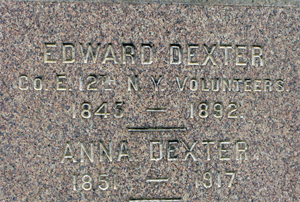
DEXTER, EDWARD (1846-1892). Private, 12th New York Infantry, Companies B, D, and E; 5th New York Veteran Infantry, Company E. Born in Maryland, Dexter enlisted as a private at New York City on October 1, 1861, the same day that he mustered into the 12th New York’s Company B. After being transferred into Company D on June 23, 1863, he was transferred into Company E at some point. On June 2, 1864, he transferred into the 5th New York Veterans from which he was discharged on October 3, 1864.
As per the census of 1880, he was a clerk; the 1882-1883 and 1891-1892 New York City Directories and the 1890 Brooklyn Directory list him as a builder at 130 Broadway, living in Brooklyn. In 1891, Dexter applied for and was granted an invalid pension, certificate 1,167,330. His last residence was at 459 Halsey Street in Brooklyn. His death was caused by hemiplegia. His widow, Annie L. Dexter, also received a pension, certificate 701,283. Originally interred at Green-Wood on April 2, 1892, his remains were moved to the present location on September 26, 1906. Section 141, lot 24081.
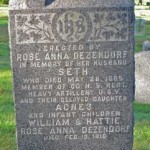
DEZENDORF, SETH (1830-1865). Sergeant, 5th New York Heavy Artillery, Company H. Dezendorf is buried at Cypress Hills Cemetery; the monument on the family’s lot at Green-Wood is a cenotaph in his memory. He was a native of Newburgh, New York. He is listed as a carpenter in the 1857-1862 Brooklyn Directory and the 1864 Brooklyn Directory, living at 53 Graham Avenue.
After enlisting as a private on August 20, 1862, at Brooklyn, Dezendorf mustered into the 5th New York Heavy Artillery five days later. As per his muster roll, he was 5′ 7½” tall with blue eyes, brown hair and a dark complexion. He was promoted to corporal on September 17, then to sergeant on October 31, and was reduced to private on November 20 of that year. He mustered out on May 23, 1865, at Harpers Ferry, West Virginia, and died five days later.
His widow, Rose Anna, had this inscribed on her gravestone, “In memory of her husband Seth who died May 28, 1865. Member of Co. H, 5th Regt. Heavy Artillery U.S.V.” According to an article about his funeral in the Brooklyn Daily Eagle on June 2, 1865, his casket was escorted to his Cypress Hills grave by members of his Masonic lodge with each Freemason dropping a sprig of evergreen, the symbol of immortality, on the coffin. Section 59, lot 1420.
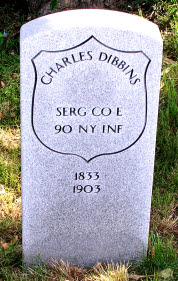
DIBBINS (or DEBBINS), CHARLES (1833-1903). Sergeant, 90th New York Infantry, Companies H and E. Born in England and the older brother of Francis Dibbins (see), he was a sea captain according to the census of 1860. He enlisted at New York City as a corporal on September 24, 1861, and mustered into Company H of the 90th on October 2. Dibbins was promoted to sergeant on February 19, 1863, transferred to Company E on April 7, 1863, and mustered out on November 27, 1864, at Camp Russell, Virginia.
On October 15, 1868, he became a naturalized citizen. As per the 1868 Brooklyn Directory, he was a lighterman, a worker on a flat-bottomed barge. The 1880 census lists him as a sea-faring man; the Brooklyn Directory of 1880 indicates that he worked as a steward. In 1890, his application for an invalid pension was approved, certificate 674,724. A member of Moses Odell Post #443 of the G.A.R., his comrades were invited to his funeral as per his obituary in the Brooklyn Daily Eagle. He last resided at 202 Greenwood Avenue in Brooklyn. His death was attributed to senility. Section 135, lot 14964, grave 165.
DIBBINS, FRANCIS (or FRANK) JOHN (1842-1909). Private, 90th New York Infantry, Companies H and A. Originally from England, Dibbins was a sea man according to the census of 1860. He enlisted at New York City on September 24, 1861, and mustered into Company H of the 90th on October 2. His older brother, Charles Dibbins (see), served in the same regiment. As per his muster roll, he was detailed to recruiting duty on September 17, 1862, deserted from the recruiting station at New York on an unstated date, returned to duty without trial per S.O. #217 and was reassigned to Company A on August 25, 1864. Dibbins mustered out on December 10, 1864, at New York City.
On October 15, 1868, Dibbins became a naturalized citizen. The census of 1870 and the 1880-1882 Brooklyn Directory indicate that he was an engineer; he is listed as a steam engineer on the census of 1880. Dibbins is listed as an engineer in the 1890-1892 Brooklyn Directory, living at 41 Reid Avenue. In 1890, his application for an invalid pension was granted, certificate 925,355. The Veterans Schedule of 1890 confirms his Civil War service. Dibbins was still employed as an engineer according to the census of 1900. As per his obituary in the Brooklyn Daily Eagle, a requiem mass was held in his memory at the Visitation Church on Richard Street; his death was also announced in The New York Times. He last resided at 41 Reid Avenue in Brooklyn. His death was attributed to pneumonia. Section 206, lot 30338, grave 2.
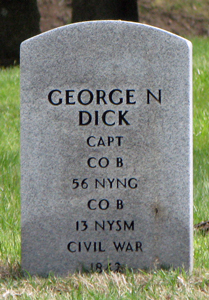
DICK, GEORGE N. (1842-1908). Captain, 56th Regiment, New York State National Guard, Company B; private, 13th Regiment, New York State Militia, Company B. Born in Harlem, New York City, he enlisted at Brooklyn on April 23, 1861, and served as a private in the 13th New York State Militia, Engineer Corps. His company left New York on April 23, 1861, and served as infantry in Annapolis and Baltimore, Maryland. A descendant owns what appears to be an early Confederate flag; it is accompanied by a note, in contemporary hand, stating that Dick captured that flag in Baltimore. That note reads: “Rebel flag taken from pole in city of Baltimore by George N. Dick and Josh —— of ‘Engineer Corps’ 13th Regiment NGSNY.” He mustered out with the 13th on August 6, 1861. He re-enlisted as a first lieutenant at Brooklyn on June 18, 1863, was commissioned into Company B of the 56th National Guard on that day, and mustered out after 30 days on July 24 at Brooklyn. He was commissioned into the same regiment and company on August 2, 1864, promoted to captain on that day, and mustered out at New York City on November 6, 1864.
He is likely the George N. Dick who is listed as a clerk living at 43 Johnson Street in the 1866 and 1868 Brooklyn Directories. The 1880-1882 Brooklyn Directory lists him as employed in insurance on Court Street. Active in Republican Party politics, he was employed as a deputy internal revenue collector for twenty years and supervisor of supplies for the Brooklyn Department of Public Works. Known as “Captain Dick,” he was a member of veterans groups from the 13th and 56th Regiments and was a member of the Henry M. Lee Post #21 of the G.A.R. from 1877-1881. He later was an officer in the McPherson-Doane Post #499 of the G.A.R. As per the 1890-1892 Brooklyn Directory, he was a deputy collector at 44 Court Street, living at 673 Gates Avenue. The Brooklyn Standard Union noted on January 23, 1895 that he was appointed by the Common Council as one of the Commissioners of Deeds for Brooklyn for 1895-1896. In 1904, his pension application was approved under certificate 1,090,076. His last residence was at 324 Tompkins Avenue in Brooklyn. Apoplexy is listed as the cause of his death. Section 75, lot 10097.
DICK, HENRY (1847-1904). Private, 15th New York Heavy Artillery, Company C. A Brooklyn native, he served in the 15th Heavy Artillery although the specific details of that enrollment are not known. After the War, he belonged to George C. Strong Post #534 of the G.A.R. In 1899, he successfully applied for an invalid pension, certificate 1,018,325. As per the Brooklyn Directory of 1888-1890 and the census of 1900, he worked in the restaurant business. He last lived at 938 Gates Avenue in Brooklyn. Appendicitis led to his death. His widow, Adele Dick, received a pension in 1904, certificate 571,807. After Adele Dick’s death in 1906, Meta Krusa, guardian, applied for and received a pension for three minor children, certificate, 613,534. Section 57, lot 2784, grave 4.
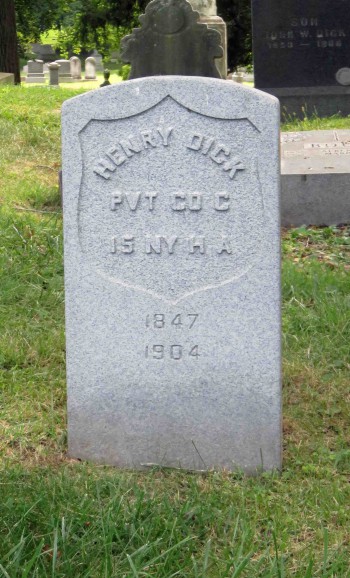
DICK, WILLIAM BRISBANE (1826-1901). Private, 7th Regiment, New York State Militia, Company F. Originally from Philadelphia, Pennsylvania, Dick was a publisher with the firm of Dick & Fitzgerald which in the 1850s specialized in songbooks of lyrics including those for minstrel shows, which today are considered racist. During the Civil War, he enlisted on April 26, 1861, mustered into the 7th Regiment, and was discharged with his comrades on June 5, 1861.
The New York City Directory for 1876-1878 lists him as a publisher at 18 Ann Street living at 319 West 38th Street. On February 9, 1882, he mustered into Marquis de Lafayette Post #140 of the G.A.R.; he lived at 45 West 25th Street in Manhattan at that time and was employed as a publisher. Many publications are credited to his authorship including books on games with rules for American gentlemen, the art of gymnastics, cribbage, solitaire and other card games such as poker, social amusement for evening parties and an encyclopedia of practical receipts and processes. The Brooklyn Directory for 1885-1886 and the New York City Directory for 1891-1892 list him as a publisher at the same business address and home address as in 1878. At the time of his passport application in 1889, he was 5′ 10½” tall with grey eyes, grey hair, fair complexion, prominent nose, medium chin and oval face.
As per his obituary in the New York Tribune, Dick was a well-known Grand Army man and left his publishing business in the hands of his son, Harris B. Dick, when he retired a few years before his death. He last lived at the Park Avenue Hotel in New York City but died of brain congestion in Pittsfield, Massachusetts. On June 4, 1903, the Duluth Minnesota’s Evening Herald reported that Brisbane’s book, Encyclopedia of Practical Receipts, was a new book in its library. Section 12, lot 7657, graves 7 and 8.
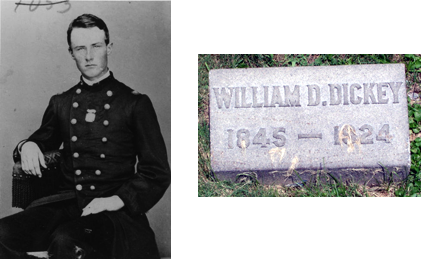
DICKEY, WILLIAM DONALDSON (1845-1924). Medal of Honor recipient; lieutenant colonel by brevet, major, 15th New York Heavy Artillery, Company M; first lieutenant, 168th New York Infantry, Company I; sergeant, 19th Regiment, New York State National Guard, Company I. Born in Newburgh, New York, he had gray eyes and dark hair. He was educated at Newburgh Academy and Mount Retirement Seminary of Deckerstown, New Jersey. Dickey began his illustrious military service when he enlisted at Newburgh as a sergeant on May 26, 1862, the same day that he mustered into the 19th. He mustered out at Newburgh on September 6, 1862, and was promoted to first lieutenant on November 26, 1862, effective upon being commissioned into the 168th New York from which he mustered out at Newburgh on October 31, 1863.
Promoted to captain on February 3, 1864, Dickey was commissioned into the 15th Heavy Artillery that day. His leadership was recognized on June 3, 1896, when he was awarded a Medal of Honor for his action at the Battles of Weldon Railroad and Chapel House, Virginia. His commendation was for “most distinguished gallantry in action at the Battle of Petersburg, Virginia, June 17, 1864, when, refusing to leave the field and remaining in command after being wounded by a piece of shell, led his command in the assault on the enemy’s works on the following day.” In late 1864 and early 1865 he was in command of the 3rd Battery of the 15th. On May 22, 1865, he rose to the rank of major, replacing the recently deceased Emil Duysing (see), and mustered out on August 22, 1865, at Washington, D.C. On June 22, 1867, he was brevetted lieutenant colonel for “gallant and meritorious services during the war.”
On June 25, 1868, Dickey married Kate W. Richmond. He attended Albany Law School, clerked in a law office, and served as a delegate to the New York State Constitutional Convention in 1894. On June 16, 1896, the Newburgh Daily Register reported that Dickey, a Freemason, was on the Reception Committee for the 30th Anniversary Celebration of the Hudson River Lodge. On June 19, 1899, the New York Press reported that Mayor Robert A. Van Wyck appointed him to a committee to plan a reception and welcome for Admiral of the Navy George Dewey upon his return to the United States after his victory at Manila Bay in the Spanish-American War. Dickey served as a justice of the New York Supreme Court, elected as a Republican, from 1900 through 1907. The Brooklyn Daily Eagle reported on July 3, 1919, that Dickey was part of a special train tour group sponsored by the newspaper and visiting park sites; the group was scheduled for a special tour with a stop for tea in Chicago and a meeting with Governor Allen of Kansas. He was granted an invalid pension, certificate 1,146,051. After living in Newburgh, New York, he moved to Brooklyn in 1896, where he last lived at 630 Ocean Avenue. He succumbed to cardiac arrest. Section 191, lot 34493.
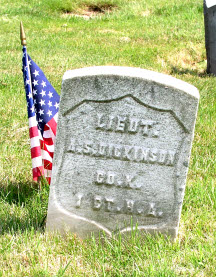
DICKINSON (or DICKENSON), ALFRED S. (1821-1904) Second lieutenant, 1st Connecticut Heavy Artillery, Company K. A native of Connecticut and resident of Hartford, he enlisted and was commissioned as a second lieutenant in the 1st Connecticut on May 23, 1861. The 1st Connecticut Artillery was formed from the 4th Connecticut Infantry. He resigned on December 18, 1861.
The 1873-1876 Brooklyn Directory and the 1875-1876 and 1876-1878 New York City Directories list Dickinson in the window shades, patent drop shade fixtures and awning business at 388 Canal Street and living at 24 Kossuth Street in Brooklyn. As per the 1880 census and the 1885-1886 and 1888-1890 Brooklyn Directories, he was an awning manufacturer. The Veterans Schedule of 1890 confirms his military service. In 1890, he applied for an invalid pension which was granted, certificate 629,761. He died of a fractured skull.
An article in the New York Herald on February 16, 1905, noted that he left $1 to one of his daughters (with whom he had previous legal troubles) and the remainder of his estate to his other daughter, E. A. Kelley, who was married to Benjamin F. Kelley, a noted handwriting expert and authority on old Jerusalem. As per an article in the Evening Telegram on November 23, 1910, Mrs. Kelley sold most of her late husband’s collection of old maps, engravings and rare books through an advertisement in that newspaper. Section 135, lot 27263, grave 1366.
DICKINSON (or DICKENSEN), LOFTUS (1831-1877). First lieutenant, 158th New York Infantry, Company G; corporal, 162nd New York Infantry, Company G. Born in New York, Dickinson was a wood engraver whose personal estate was valued at $1,000 as per the census of 1860. During the Civil War, he enlisted as a corporal at New York City on August 28, 1862, and mustered into the 162nd New York, also known as the “Third Metropolitan Guard,” on October 18. He was an engraver who was 5′ 9″ tall with blue eyes, brown hair and a dark complexion. Dickinson was reduced to the rank of private on December 26, 1862. He was detailed to the Regimental Quartermaster’s Department from November 1862 through March 1863, and served as a regimental ordnance sergeant on “extra duty” in January and March 1863. In April 1863, he was on duty on the ammunition train, then returned to “extra duty” as regimental ordnance sergeant in June and July of 1863. His muster roll notes that he was absent on detached duty to New York as per Special Order 95 in August 1863, returned to his company briefly in December 1863, then was absent on the same duty in New York from December 1863 through June 1864. During his term of duty, the 162nd was deployed to Washington, D.C., sent to Hampton Roads, Virginia, and then to New Orleans, Louisiana.
Dickinson re-enlisted as a second lieutenant on January 22, 1864, and was commissioned into the 158th New York on that date. Although he was promoted to first lieutenant on August 31, 1864, he never mustered into the 158th in either rank or date. (His widow’s pension records confirm that he was not found on the rolls of the 158th New York Infantry.) His detached service in New York proved to be problematic when he sought to be commissioned into a new regiment without any official discharge papers. According to a descendant, Dickinson encountered some problems when he tried to report to the 158th; he was picked up by the Office of the Provost Marshal as a deserter and returned to the 162nd. The family story indicates that the Army never officially discharged him from the 162nd and that Dickinson was unable to “find” the 158th Regiment. This story is corroborated by letters from the provost marshal written on June 14th, 1864 (when Dickinson was detached to New York), another from the 158th written on September 1, 1864, and a written document by Dickinson. The letters state:
(Letter 1-June 14, 1864-written to the assistant adjutant general from the Office of the Provost Marshal in New York’s 6th Congressional District by Captain Coster)
Sir: One of my detectives has arrested Private Loftus Dickinson, 162nd Vols. as a deserter. The man has a commission in the 158th N.Y. Vols. and claims to be awaiting orders from the War Dept. in order to be mustered in this regiment.
As he has never been mustered out of the 162nd Regt. N.Y. Vols he should be returned to that Regt.; but as he claims to have acted under advice from you, I have taken the liberty to send him to your office in order to find out the truth of his statement.
On June 16, 1864, Coster was informed that Dickinson was ordered to return to New Orleans, where the 162nd was stationed, by the “next transport.” The following note by an officer of the 158th confirms that Dickinson tried to fulfill his duty:
(Letter 2-Written on September 1, 1864) This is to certify that Loftus Dickinson having in his possession a commission as 2nd lt. in my regt. reported to me for duty as such on the 30th day of August 1864, and from papers in his possession I am convinced that he made every possible effort to report at an earlier day, but in consequence of not reporting sooner, his commission has been revoked and another individual commissioned in his place.
On October 30, 1864, Dickinson attested in writing to the adjutant of the 162nd New York:
I, Loftus Dickinson, do solemnly swear that I received on the 6th day of October 1864, a commission (or appointment), bearing date from the 4th day of October 1864, as First Lieutenant of the 158th Regiment of New York State Volunteer Infantry, that the vacancy occurred by the discharge of First Lieutenant James Brannigan on or before the 31st day of August 1864, that I was last borne on the Muster and Pay-Roll of Company G in the 162 Regiment of New York State Volunteer Infantry as a Private (my former grade) by the 31st day of August 1864, and that I made every effort to be mustered into the service of the United States at an earlier date, but without success for the following reason: that I was unable to obtain my discharge at an earlier date being absent from my Regiment on Detached service.
Dickinson’s records show that he carried a hand-written note which said, “Where is the 158th New York?” On that same note is the hand-written response, “Not with this Army.” It was determined that Dickinson should be discharged; hence, his discharge on November 15, 1864. He was officially discharged for promotion on November 17, 1864, to date from November 15, 1864, at Newtown, Virginia, by reason of “having received promotion as 1st lieutenant to 158th New York.” Yet, there is no evidence that he ever “found” or served with the latter regiment. His name appears on the muster roll of the 162nd when his company mustered out on October 12, 1865, at Savannah, Georgia; there is a note that he was discharged for promotion on November 14, 1864.
The 1868 Long Island City Directory lists him as an engraver; according to the census of 1870, he was living in Astoria, New York, working as a wood engraver. His last residence was on Gold Street in Brooklyn. In 1892, his widow, Margaret Dickinson, received a pension, certificate 371,797. Section 162, lot 15103.

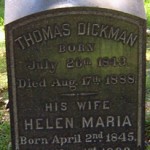
DICKMAN, THOMAS (1843-1888). Private, 9th New York Infantry, Company A. Dickman, the son of a sea captain, was born in Augusta, Maine. A clerk as per his draft registration, he was 5’8″ tall with a fair complexion. He enlisted at New York City as a private on August 14, 1862, mustering into the 9th New York the same day. On September 17, 1862, at the Battle of Antietam, he suffered a gunshot wound to his right foot and was hospitalized at Frederick, Maryland. He was discharged for disability on April 21, 1863, at New York. His application for an invalid pension was granted in 1871, certificate 177,988.
As per the 1868 Brooklyn Directory, he was a broker at 100 Wall Street. According to the census of 1870, he was a ship broker; the census of 1880 lists him as living in Essex County, New Jersey, and working as an agent for a steamship company. He last lived at 395 Nostrand Avenue, Brooklyn. On May 31, 1888, he was admitted to Kings County Insane Asylum where he died on August 17 of “general paralysis of the insane.” Helen M. Dickman, applied for and received a widow’s pension in 1890, certificate 316,476. Section 200, lot 23673.
DICKSON, JOHN F. (1821-1880). Police Officer, New York City Draft Riots. A New York City native, he was a printer before joining the police force in 1850. He later joined the Metropolitan Police Force in 1857 as acting captain of the 6th Precinct, then was relegated to police sergeant in 1859 when the leadership of the department changed. Dickson became captain of the 28th Precinct on May 1, 1860.
Together with drillmaster Theron S. Copeland (see), Dickson led a police squad during the New York City Draft Riots in July 1863. Their squad was dispatched when rioters were attacking African-Americans at Washington and LeRoy Streets. Dickson’s men were then sent to recover the bodies of those killed in the melee. A mob was dispersed on Clarkson Street where the body of William Jones had been tortured and hanged from a tree. According to The Metropolitan Police, Their Services During Riot Week, Their Honorable Record by David M. Barnes, Captain Dickson was at Leroy Street at 5:00 a.m. where he happened upon an African-American man who had been severely beaten by a rioter who bludgeoned his head five or six times with a 20 pound stone. Dickson secured a wagon to take the injured man to the hospital, but the man, who uttered his name, “Williams,” died shortly thereafter. Three men were later arrested for that murder.
Barnes wrote that Dickson and the men of the 28th Precinct were under Inspector George W. Dilks (see) on Tuesday at 10:00 a.m. at the Union Steam Works where the mob had seized weapons and a severe fight ensued that tested the “mettle” of the police. Dickson’s men were then assigned by Inspector James Leonard (see) to report to Printing House Square until Saturday, July 18, 1863, to control any disturbances. Dickson’s men, together with Companies A and B of the 74th New York Infantry, were detailed to towns and cities along the Hudson River as far north as Peekskill, New York, where they were greeted with much enthusiasm. They returned to their precinct on July 22. Dickson was then sent to Port Richmond, Staten Island, the scene of previous disturbances, and, finding all quiet, was sent that evening to Flushing, where along with members of the 7th New York National Guard, they patrolled and remained overnight before returning to the 28th precinct on July 23. Author Barnes went on to praise Dickson, “whose example and endurance encouraged his men.”
When Dickson was transferred to the 11th Precinct on July 11, 1869, local businessmen presented him with a house and small lot in Harlem as a token of their appreciation for his diligent service. Although he became a police superintendent in the spring of 1870, he came under considerable fire when he was transferred to the 31st Precinct on July 28 and resigned on August 20. Assigned to the detective squad, he suffered from depression and a “broken spirit.” Subsequently, he was the head of the Tombs Police Court for many years and, at the time of his death by cancer, was among the oldest serving police officers. He last lived at 32 Stuyvesant Street in Manhattan. Section 16, lot 7260.
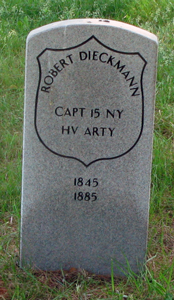
DIECKMANN (or DIECKMAN), ROBERT (1845-1885). Captain by brevet; first lieutenant, 15th New York Heavy Artillery, Companies K, H, C, E, G, and L. Of German birth, he enlisted as a private at New York City on August 18, 1863, and immediately mustered into Company K of the 15th New York Heavy Artillery. As per his muster roll, he was a machinist by trade who was 5′ 10″ tall with brown eyes, black hair and a dark complexion. During his service, he was promoted to corporal on December 1, 1863, transferred to Company H on April 1, 1864, and to Company C on August 16 of that year. Upon his promotion to sergeant on about September 1, 1864, he was transferred to Company E. He was promoted to second lieutenant on September 10, 1864, and transferred again six days later to Company G. On June 1, 1865, he was promoted to first lieutenant and transferred to Company L. He mustered out on August 22, 1865, at Washington, D.C. Dieckmann was brevetted captain on January 24, 1866, “for gallant and meritorious services.” On January 28, 1867, he became a naturalized citizen.
The 1876 Brooklyn Directory lists him as a machinist; the census of 1880 notes that he was a policeman. His last address was 1133 Third Avenue in Brooklyn. He died of phthisis. Anna E. Dieckmann, his widow, who is interred with him, applied for a pension in 1889, certificate 354,080. In 1892, Eleanor Kassenbrock, his sister-in-law and guardian of his child(ren), applied for a minor’s pension, certificate 354,051. Section 43, lot 5216.
DIEHL, LOUIS (1825-1882). Private, 41st New York Infantry, Company E. Of German birth, he enlisted at New York City as a private on June 6, 1861, mustered into the 41st New York that same day, and mustered out on June 9, 1861, at Hilton Head, South Carolina. He last lived on Madison Street in New York City. Diehl’s death was caused by uremia. Section 2, lot 5499, grave 868.
DIETRICH, AUGUST (1839-1898). Private, 39th New York Infantry, Companies E and B. A German native, Dietrich enlisted as a private at New York City on May 13, 1861, and mustered into Company E of the 39th New York on May 28. He was transferred to Company B on May 31, 1863, and mustered out at New York City on June 24, 1864. His application for an invalid pension was approved, certificate 635,807. As per his death certificate, he was a widower and worked as a a mechanic. He last lived at 540 Union Place in Union, New Jersey. His death was attributed to cirrhosis of the liver. Section 144, lot 28949, grave 3.
DIGGS, DABNEY W. (1837-1924). Major, 83rd New York Infantry, Companies C and B; captain, 53rd New York Infantry, Company E; 132nd New York Infantry, Company B. A native of Shelby County, Kentucky, who was employed as a clerk, Diggs enlisted as a private at New York City on May 27, 1861, and mustered into Company C of the 83rd New York that day. As per his muster roll, he was 5’6″ tall with grey eyes, dark hair and a fair complexion. Promoted to corporal, he was discharged for promotion on May 30, 1862, and commissioned as a first lieutenant of Company E of the 53rd New York, but did not muster in. Diggs was again promoted, this time to captain, on July 7, 1862, and transferred to Company B of the 132nd New York Infantry on September 10, 1862, upon consolidation of the regiments. On January 10, 1863, he was commissioned major of the 83rd New York, Company B, but did not muster into the regiment in that rank. He was discharged for disability on March 20, 1863.
In 1877, Diggs applied from the Dakota Territory for an invalid pension that was granted, certificate 440,762. His service was confirmed by the 1890 Veterans Schedule in Milbank, South Dakota. That document indicates that he was ruptured in the saddle when his horse fell and that’s what led to his disability discharge.
On March 8, 1899, he applied for a patent for fire extinguishers with spraying and projection of extinguishing agents by pressurized gas; his application noted that his invention could be used worldwide. By the time he received a patent for soda acid fire extinguishers on June 19, 1900, he was living in New York. He is listed as the president of a fire extinguishing company that bore his name in Trow’s Directory for 1904. According to the census of 1910, the New York City Directory of 1911 and the census of 1920, he was a manufacturer of fire extinguishers. His business, at 141-143 Centre Street in Manhattan, was considered one of the largest and best equipped in the nation.
Remaining active in military affairs, he was the commandant of the 83rd Veterans in 1902, and attended a Golden Reunion at the Hotel Martinique in Manhattan in 1911. Former President Theodore Roosevelt had been invited to attend; his secretary apologized to Diggs for his being unable to attend. Diggs also participated in a reunion of sixteen septuagenarians from the old 93rd in 1914. Diggs is listed as a registered voter in the 16th Election District for Manhattan, living on 55th Street, in 1924. He last lived in New York City. His death was caused by prostate cancer. Section 1, lot 6907.
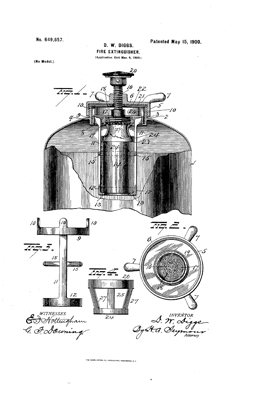
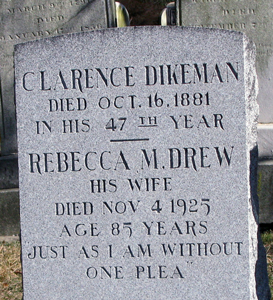
DIKEMAN (or DICKEMAN), CLARENCE (1834-1881). Private, 23rd Regiment, New York State National Guard. Company C. A Brooklynite by birth and a clerk as per the 1858 Brooklyn Directory, the census of 1860 and his Draft Registration, Dikeman served in the 23rd Regiment when it was activated for 30 days in 1863. He was listed as a clerk in the 1864, 1868 and 1873-1876 Brooklyn Directories and as an accountant on the 1880 census and 1881 Brooklyn Directory. He last lived at 587 Pacific Street in Brooklyn. Dikeman died of phthisis. A pension application, 877,496, was submitted in 1907 by his widow, Rebecca M. Drew, but no certificate number is listed. Section 26, lot 9339.
DIKEMAN, JOHN P. (1840-1864). Private, 48th New York Infantry, Company H. A Brooklynite by birth, he enlisted there as a private on August 22, 1862, and mustered into the 48th the next day. He died on the steamer Leary at Hilton Head, South Carolina, from congestion of the brain on December 2, 1864, and was interred at Green-Wood on January 23, 1865. Section 26, lot 4156.
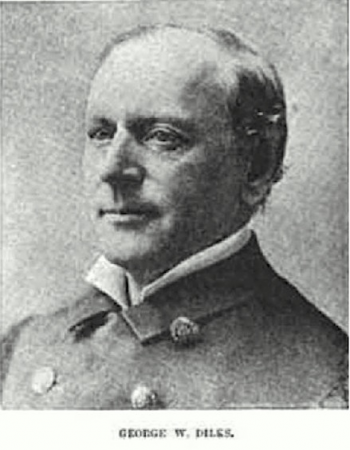
DILKS, GEORGE WRIGHT (1816-1901). Inspector, Metropolitan Police Department, New York City Draft Riots. A New York City native, Dilks’ grandfather was a British Army colonel who settled in the United States after the American Revolution. Educated in Brunswick, New Jersey, his family returned to New York when he was a teenager. A printer on Duane Street, he became friends with Aaron Burr, whose law office was in the same building as the printing establishment. Dilks became a police officer in 1848, was appointed assistant captain and commanded a squad during the Astor Place Riots in 1849. He became a captain in 1853, and won praise in 1857 after a four-day battle with longshoremen. He was the investigating officer in the Cunningham-Burdell “bogus baby” case in 1857 and later served as a witness for the prosecution. He became an inspector in 1860 when the Metropolitan Police Department was organized. During the New York City Draft Riots in July 1863, he was noted for recapturing the Union Steam Works, a wire factory converted to wartime arms production and owned by Mayor George Opdyke’s son-in-law George Farlee, after fierce hand-to-hand fighting. On July 13, the Union Steam Works was the rallying point and headquarters for rioters on the East Side of Manhattan who hoped to seize the hundreds of carbines believed to be inside. Dilks led a force of 200 officers, including all of the reserves of the 18th Precinct, against close to 500 rioters who were inside the building. According to The Metropolitan Police, Their Services During Riot Week, Their Honorable Record by David M. Barnes, at 2:00 a.m. on July 14, 1863, Dilks and his men encountered the mob who were “exultant” after plundering the factory and greeted the force with derision and defiance. Barnes wrote:
…The mob, for a while, stood its ground, and hand-to-hand encounters ensued, of which the Inspector had his full share; orders had been given to recapture all the stolen guns, and squads of the force charged for them at different points into the mob, mowing their way in and back against weighty odds. The proportions and fierce character of this fight on the one hand, and the courage on the other, made it the severest encounter of the week. The ground was strewn with men, on sidewalks, in the gutters, and on the street, bleeding and senseless. The mob, broken and terrified, fled, leaving Inspector Dilks and his command masters of the ground. Thus ended the engagement “on the field,” in which many of the force were injured, but not one faltered.
To the factory now, which was filled with rioters, still pillaging it of arms and determined to defend it, instant attention was turned. Wheeling his men to the front, Inspector Dilks gave the orders to assault and take it. The entrance was forced, the stairs won step by step, and the building cleared, but only after savage and continuous fighting, in which serious punishment was inflicted by the police; men laid throughout the factory, victims of their own lawlessness, and the bloody marks of the contest were on parts of the building. Those who escaped from within ran the gauntlet of the force remaining in the street, and few, if any, got away unscathed. The punishment inflicted during these contests was terrible; a physician dressed the wounds of twenty-one of the rioters, all on the head, and all of which he considered fatal….
Although Dilks returned to headquarters at 3:00 p.m., the rioters regrouped and once again attacked the factory. Dilks returned with another two hundred police and a contingent of the military only to find themselves closed in by a fast-gathering and infuriated mob. The military and the police were pelted with stones and other missiles as they marched through the area, Dilks surviving a close call when a Minie ball struck close to his head. The mob, emboldened, regrouped throughout the day on July 15, and Dilks was actively involved in the skirmishes when the police and military toured the same area. The police and military were fired at from the houses and the streets, and advanced slowly to disperse the mob. The military continued to patrol the area during that week after Dilks had left that area. Although offered the job of police superintendent after the Draft Riots, he did not want to take the job from John Kennedy, who was recuperating from his injuries at the hands of the mob on July 14, 1863, and Dilks remained an inspector until his retirement in 1888. He was also known for his police work in cases related to counterfeiting, prostitution and missing children. A well-known citizen, his 50th wedding anniversary was considered one of the largest celebrations of its kind in New York City attracting 150 guests including a contingent from the New York Chinese Council who considered Dilks a special friend for supporting the burgeoning Chinese American community. He succumbed to anemia. His funeral was conducted by members of the Mutual Lodge, Palestine Encampment, of the Independent Order of Odd Fellows. Many prominent Odd Fellows were in attendance. He was the brother of William W. Dilks (see). He last lived at 34 West 9th Street in Manhattan. Section 160, lot 10554.
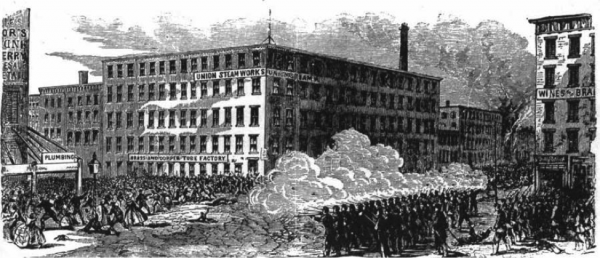
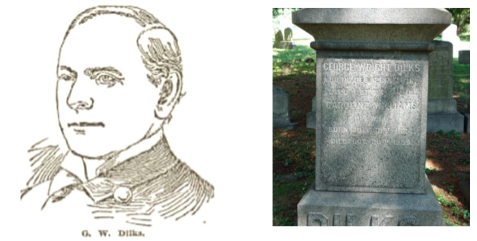
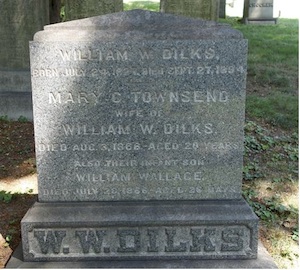
DILKS, WILLIAM W. (1827-1894). Police Officer, New York City Draft Riots. Born in New Brunswick, New Jersey, he was the brother of George W. Dilks (see). His family moved to New York City in 1833 at which time Dilks attended P.S. 11 at Wooster and Prince Streets and then private school at Prince and Mercer Streets. He apprenticed as a locksmith then, like his older brother, joined the police force in 1849 serving most of his career with the 15th Precinct. As per his obituary in The New York Times, “He was prominent during the draft riots, in 1863. His conduct at that time was note-worthy, and he received much praise for his display of bravery in handling the worst element in the city.” He retired in 1872.
His obituary notes that after he took sick he developed an uncontrollable case of violent hiccoughs that lasted for nine days, ultimately causing his death. Dilks’s obituary in the New York Herald reports that he was a Freemason and member of the Elks, the Veteran Police Association and the Vosburg Veteran Association; members of all organizations were invited to attend his funeral. He last lived at 34 West 9th Street in Manhattan but died in Catskill, New York, where he was vacationing. Section 160, lot 10554.
DILL, JAMES E. (1826-1873). Private, 5th New York Infantry, Companies D and G. Born in New York City, Dill enlisted there as a private on April 25, 1861, and mustered into Company D of the 5th New York on May 9. On November 1, 1861, he received an inter-regimental transfer to Company G. He mustered out at New York City on May 14, 1863. His last residence was 104 Allen Street in Manhattan. His death was caused by apoplexy. Section 17, lot 17245, grave 1149.
DILLANO (or DILLONO), WILLIAM L. (1844-1882). First sergeant, 65th New York Infantry, Company A; corporal, 67th New York Infantry, Company A. A native of Brooklyn, he was a clerk who was 5′ 5″ tall with blue eyes, brown hair and a light complexion. He enlisted at Brooklyn as a private on May 20, 1861. A month later on June 20, he mustered into the 67th New York Infantry, Company A. He re-enlisted on December 25, 1863, and was promoted to corporal on July 1, 1864. On September 1, he was transferred into the 65th New York Infantry, Company A, with the rank of corporal. He was promoted to sergeant on December 1, 1864, and to first sergeant on May 20, 1865. Dillano mustered out at Hall’s Hill, Virginia, on July 17, 1865.
He joined Rankin Post #10 of the G.A.R. in 1869. The 1877 New York City Directory reports that William L. Dillono was in the paper business, W. L. Dillono & Company, at 95 Barclay Street. As per the census of 1880 and the Brooklyn Directory of 1882, he was a paper merchant. Although he applied for an invalid pension in 1882, application 439,822, he apparently died of Bright’s disease before it was certified. As per his obituary in the New York Herald, members of the Rankin Post paraded in uniform and escorted his coffin to his grave. He last resided in Scotch Plains, New Jersey. It was noted in the Brooklyn Daily Eagle on May 23, 1892, that Dillano’s grave was decorated by members of the Rankin Post. Section 15, lot 17263, grave 357.
DILLER, ANTHONY S. (or JOHN) (1843-1897). Sergeant, 1st Stuart’s Horse Light Artillery, Company 1, Confederate States of America. Diller was born in Westminster, Maryland. After he enlisted as a private on June 12, 1862, at Richmond, Virginia, he mustered into Company 1 of the 1st Stuart’s Horse Light Artillery that same day. His unit was familiarly known as Captain Daniel Shanks Company and was part of General Fitz Hugh Lee’s Division, Virginia, Confederate States Army. On February 12, 1863, he was wounded in action at Smithfield, Virginia. Captured on July 30, 1863, he was on the rolls as a prisoner of war at the U.S. Hospital at Winchester, Virginia, on August 15, 1863, and returned on November 12, 1863.
On January 15, 1864, and on February 15, he was listed as detached to special detail. From April 30 to August 31, 1864, he was detailed as a clerk at the Nitre & Mining Bureau. A letter dated May 31, 1864, from that bureau states that he was detailed because of debility resulting from gunshot wounds at the Battle of Shepherdstown [West Virginia], and was entitled to double pay. He was paroled on April 28, 1865, from Danville, Virginia, and on May 26, 1865, when he took the Oath of Allegiance as part of General Fitz Hugh Lee’s Division. Although his obituary in The New York Times states he was a colonel who commanded a regiment during the Civil War, in fact the highest rank he achieved was sergeant.
In 1866, Diller moved to New Jersey, owned an iron foundry and tracts of land along the Palisades. He was also a lawyer who lived the last four years of his life at the Taylor’s Hotel in Jersey City, New Jersey, where at one point he struck a young lawyer on the head with a cane after a verbal dispute at the hotel’s bar. The cause of his death is listed as “acute nephritis diffuse.” Section 203, lot 26529, graves 2 and 3.
DILLMAN, CHRISTIAN LUDWIG (1831-1880). Private, 151st New York Infantry, Company E. Born in Baden-Württemberg, Germany, Dillman enlisted at Rochester, New York, as a private, on August 20, 1862. On October 22, he mustered into Company E of the 151st New York from which he mustered out at Washington, D.C., on June 26, 1865. He is listed as a collector in the 1868 Brooklyn Directory living at 800 Atlantic Avenue. His last residence was 631 Pacific Street in Brooklyn. He was survived by his widow, Bertha née Reicks and two children. Section 59, lot 1405, grave 45.

DILLON, JAMES (1830-1891). Private, 5th New York Heavy Artillery, Companies A and K (?). Of Irish birth, he may be the James Dillon who mustered into Company A of the 5th New York Heavy Artillery on April 9, 1864, transferred into Company K on June 1, 1865, and mustered out on July 19, 1865, at Harpers Ferry, West Virginia. This man had prior service in the 15th New York. He last lived in Fort Hamilton, Brooklyn. Dillon died from valvular heart disease. Section 19, lot 5397.
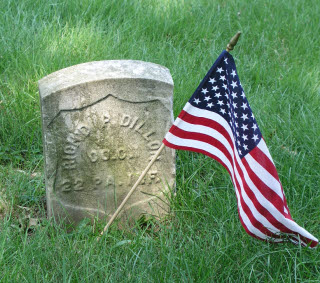
DILLON, RICHARD P. (also enlisted as DAVIS, FRANK P.) (1838-1913). Private, 22nd Pennsylvania Infantry, Company C; 2nd Pennsylvania Reserve Infantry, Company B; 191st Pennsylvania Infantry, Company B. A clerk on the Pennsylvania Railroad at the time of his enlistment, Dillon was born in Philadelphia, Pennsylvania, to Irish immigrants. He enrolled there as a private on April 23, 1861, mustered into the 22nd Pennsylvania and mustered out on August 7 at Philadelphia. He re-enlisted on October 29, 1861, and mustered into the 2nd Pennsylvania Reserve Infantry which was later consolidated into the 191st Pennsylvania Infantry. On September 14, 1862, he was wounded in action by gunshots to his left hip and right ankle at South Mountain, Maryland, for which he was treated at White House Hospital for several days before being sent to Christian Street Hospital in Philadelphia for two months of rehabilitation. He then returned to his regiment and was honorably discharged near Warren Station, Virginia, on October 29, 1864.
After the Civil War, he assumed the alias Frank Davis and joined Company G of the 6th United States Cavalry as a sergeant from which he was honorably discharged as a private at Sulphur Springs, Texas, in April 1869. In 1872, he received an invalid pension, certificate 125,390. As per the censuses of 1900 and 1910, he was living in Jersey City, New Jersey, and working as a U.S. customs agent. He last lived in Jersey City. He died from chronic endocarditis. His widow, Maria Dillon, who is interred with him, was granted a pension upon his death in 1913, certificate 756,700. Section 132, lot 32456.
DIMOCK, JOSEPH JUDSON (1827-1862). Major, 82nd New York Infantry. Dimock was born in Petersburg, Virginia, and educated in Connecticut. A mercantile agent in Boston, New York, and New Haven, he had dealings with Cuba through connections to his wife’s family, the DeWolfs, who had sugar plantations there. A collection of the Dimock family papers is in the library at Emory University. Among Joseph’s pre-Civil War letters are memories of daily life including school, boarding house life, illness, visits and special events in his life including his wedding day, the birth of his children and the 1860 visit of the Japanese Delegation to New York.
At the time of his enlistment, Dimock was an author, having written Impressions of Cuba in the Nineteenth Century: The Travel Diary of Joseph J. Dimock, published in 1859. That book provided an insight into the sugar industry, the lives of enslaved people, Spaniards and Cubans and an overview of the social, economic and political conditions on the island. He enlisted as a major on May 21, 1861, at New York City, and was immediately commissioned into the 82nd New York. His letters on Army life were recollections of camp life, his opinions of fellow officers, the mustering of forces in Washington, D.C., and the preparations for and his part in the First Battle of Bull Run, Virginia. On November 24, 1861, he described the harsh winter conditions and lamented a dissatisfaction with a government in whose “army operations political favor seems to be the governing power.” He died of disease on June 22, 1862, in Baltimore, Maryland. Letters about Dimock’s death, photographs, uniform insignia and other mementoes are part of the material housed at Emory. Although Dimock is not interred at Green-Wood Cemetery, his son is, and the son’s gravestone identifies Judson DeWolf Dimock as the “son of Isadora Louise and Major J. J. Dimock.” Section 195, lot 25278.
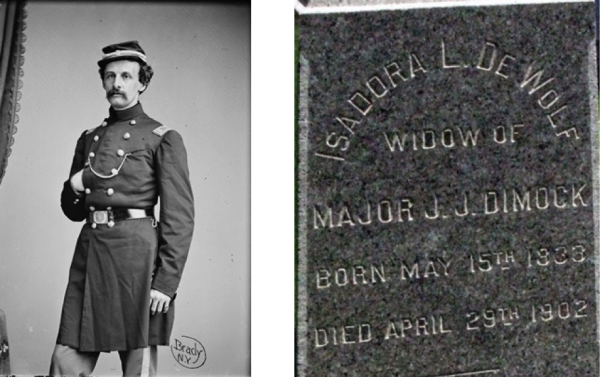
DIMOND, MORGAN (1837-1920). Private, 79th New York Infantry, Company G. Of Irish birth, he enlisted as a private at New York City on May 13, 1861, and mustered into the 79th New York on May 28. After being wounded at Chantilly, Virginia, on September 1, 1862, he was discharged for wounds on September 15 at Alexandria, Virginia. Dimond became a naturalized citizen on September 1, 1867. He worked as a porter at the time of his naturalization and is listed as such in the 1868 New York City Directory. By 1880, the census listed him as a resident of the New York City Asylum for the Insane. In 1881, he applied for and received an invalid pension, certificate 255,209. He died in the Manhattan State Hospital on Ward’s Island where he lived for 20 years. Section D, lot 7642, grave 191.
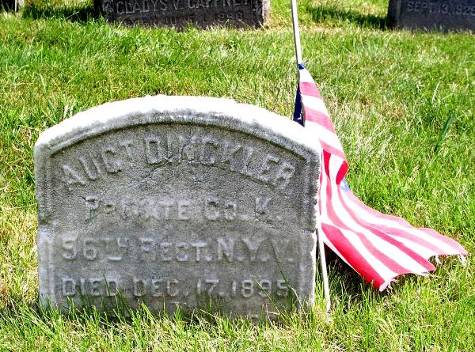
DINCKLER (or DINKLER), AUGUST (1848-1895). Private, 56th Regiment, New York State National Guard, Company K. Dinckler served for 100 days with the 56th Regiment in 1864. According to the Veterans Schedule from 1890, he served from July 8 through November 8 of that year.
Dinckler was a carriage painter by trade as noted in the censuses of 1870 and 1880. A member of Devin Post #148 of the G.A.R., he also belonged to the Veterans Association of the 56th National Guard. Although he applied for a pension in 1893, application 1,146,879, he apparently died before it was granted. He last resided at 134 Willoughby Street, Brooklyn. Dinckler died of nephritis. His gravestone, circa 1900, confirms his service in the 56th New York. Section 134-135, lot 27263, grave 810.
DISCH, JOSEPH (1829-1866). Private, 93rd Regiment, New York State National Guard, Company H. Originally from Germany, Disch enlisted at New York City as a private in 1864. He mustered into the 93rd Regiment’s National Guard for its activation of 100 days and was discharged at the expiration of his enlistment. His last residence was 110 West 21st Street in Manhattan. Disch died from cholera. Section 110, lot 10456.
DISOWAY (or DISOSWAY), WILLIAM W. (1843-1863). First lieutenant, 1st New York Mounted Rifles, Company M; second lieutenant, 1st New York Cavalry, Companies B and C. Originally interred at Green-Wood, he was removed from the cemetery on October 14, 1864. Enlisting on July 19, 1861, as a corporal, Disoway, a native of New York, mustered that day into Company B of the 1st New York Cavalry at Lincoln, New York. On June 20, 1862, he was promoted to sergeant, and was promoted to second lieutenant effective upon his transfer to Company C on August 13, 1862. Subsequently, he was transferred into Company M of the 1st New York Mounted Rifles on November 19, 1862, and was promoted to first lieutenant on December 20. Disoway died of gunshot wounds on October 13, 1863.
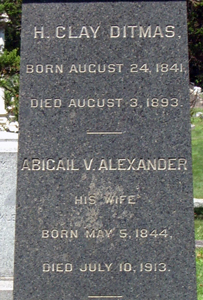
DITMAS, HENRY CLAY (1841-1893). Private, 84th New York (14th Brooklyn) Infantry, Company E. Ditmas enlisted on April 18, 1861, at Brooklyn, and mustered into the 14th Brooklyn on May 23. He was discharged for disability on July 27, 1861, at Arlington, Virginia. Though he applied for an invalid pension on February 10, 1862, application 396, the pension was not granted.
After starting out as a saloon keeper as per the 1880 census, Ditmas amassed a fortune as a turf correspondent who supplied information on horseracing via telegraph to poolrooms on the East Coast. A resident of Gravesend, Brooklyn, he was connected to racetracks in Brighton Beach and Sheepshead Bay, paying Western Union $100 a day for supplying the information about the races, jockeys, and race results to other cities. He came to inherit the business after the man who deputized him, Joseph Mitchell, died.The business, the Ditmas News Company at 195 Broadway, continued to be profitable after a toll was enforced by the racing associations. On January 18, 1892, the Brooklyn Daily Eagle reported in a reminiscence, “Down the Road, Sleighs on the Parkway Suggest Old Times,” that Ditmas ran a moose on a snowy track in Gravesend, Brooklyn, in 1874, starting his road to fortune. That article mentioned that he was worth a couple of hundred thousand in 1892.
At the time of Ditmas’s death, he was worth more than a quarter of a million dollars as per his obituary in The New York Times(the equivalent of $7.2 million in 2021). The Brooklyn Daily Eagle attributed his death to heart disease but The New York Times cited Bright’s disease; both said his death was sudden. As per an article about his death in the New York Herald on August 4, 1893, he earned about $500 per day just from New York City poolrooms before they were closed down by law. He was a heavy bettor as well and owned a horse farm at Springfield in Jamaica, Queens.
After his death, some of his relatives sought to inherit his estate by arguing that his second marriage, after Ditmas had obtained his divorce, was illegitimate because he had not gotten the court’s permission to marry. He last lived on Kings Highway in Brooklyn. He was survived by his widow, Abigail née Alexander, who is interred with him, and two children. On June 1, 1915, the Brooklyn Daily Eagle reported that Henry Clay Ditmas, the young grandson of Ditmas and his namesake, was a favorite at the Brooklyn Historical Pageant wearing a Zouave uniform as the mascot of the 14th Regiment. Section 154, lot 28536.
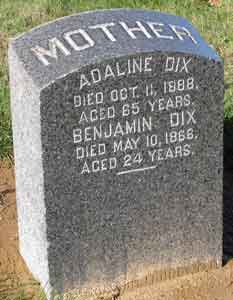
DIX, BENJAMIN (1843-1866). Private, 12th Regiment, New York State National Guard, Company C. A native of New York City, Dix enlisted and served in the 12th Regiment for three months in 1862. When the regiment was reactivated for 30 days in 1863, he returned to the same company. He last lived at 65 Greene Street in Manhattan. Section 121, lot 7639, grave 62.
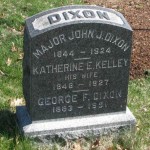
DIXON, JOHN J. (1844-1924). Corporal, 144th New York Infantry, Company I. After Dixon enlisted as a private on August 14, 1862, at Sidney, New York, he mustered into the 144th New York on September 27. His pension record indicates that he was a corporal in the 144th but no date is given for that promotion. He mustered out of service at Hilton Head, South Carolina, on June 25, 1865. Subsequently, he served as a major in the 71st New York, the rank that is inscribed on his gravestone, during the Spanish-American War.
New York’s Governor John Dix, who served from 1911-1912, appointed Dixon as a commissioner to regulate and supervise boxing contests in accordance with the Frawley Law (1911). As per an article on that appointment in The New York Times on July 27, 1911, Dixon was a former secretary-treasurer of the Amateur Athletic Union (A. A. U.). In addition, he served as handicapper, secretary and chairman of the Athletic Committee of the Military Athletic League. The article also notes that he joined the 47th Regiment in 1882 and retired with the rank of regimental quartermaster as brevet major. He was promoted to captain on January 10, 1884, and brevetted to major on December 6, 1899.
He was a member of the William Rankin Post #10 of the G.A.R. and the United Spanish War Veterans. In 1890, his application for a pension was granted, certificate 747,273. He last lived at 2459 Bedford Avenue in Brooklyn. His death was attributed to apoplexy. Katherine Kelley, who is interred with him, applied for and was granted a widow’s pension in 1924, certificate 951,090. Section 204, lot 29730, grave 3.
DIXON, JOSEPH (1799-1869). Inventor and entrepreneur who pioneered the industrial use of graphite. A Massachusetts native, Dixon started out as a printer and lithographer in Salem, Massachusetts. His experiments lead to the discovery of many uses of graphite and graphite crucibles, including lead pencils, stove polish and lubricants. Other inventions of his were in printing and photography and included a technique for printing banknotes that prevented counterfeiting. Dixon moved his business to New Jersey, building the Dixon Mills in Jersey City in 1847.
During the Civil War, the demand for portable writing instruments for soldiers led to the mass production of pencils. The Joseph Dixon Company (now Dixon Ticonderoga) was the world’s largest manufacturer of lead pencils by the time Dixon died in 1869. Section 4, lot 16354.

DOAK, GEORGE F. (1840-1910). Quartermaster, 84th Regiment, New York State National Guard, Company F; sergeant, 71st Regiment, New York State National Guard, Company G. A New York City native, and brother of William Doak (see), George Doak served with the 71st Regiment, first as a private for three months in 1861 and then as a sergeant for three months in 1862. Doak re-enlisted on July 13, 1863, at New York City as a first lieutenant, was commissioned into the 84th National Guard the same day, and mustered out after 30 days on August 4 at New York City. On July 13, 1864, he was promoted to quartermaster and commissioned into the same regiment’s Field and Staff where he served for 100 days.
As per the New York City Directory for 1866, he was a stationer at 85 Broad Street in Manhattan; he was listed as working at the same position on the 1870 census. The 1877 New York City Directory reports that he was a clerk living at 333 West 50th Street. According to the 1880 census, he was a clerk in a provisions store. The 1889 New York City Directory and the census of 1900 indicate that he was a contractor. In 1904, he applied for and was granted an invalid pension under certificate 1,094,319. As per his obituary in the New York Herald, members of the Tammany Hall General Committee and the William L. Marcy Tammany Association were requested to attend the funeral of their comrade. He last lived at 1466 St. Nicholas Avenue in Manhattan. His death was attributed to cirrhosis. In 1910, Emily Doak, applied for and received a widow’s pension, certificate 712,099. Section 164, lot 16028.
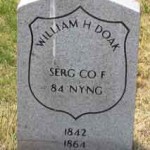
DOAK, WILLIAM H. (1842-1864). Sergeant, 84th Regiment, New York State National Guard, Company F. A New Yorker by birth, Doak served for 100 days in the 84th New York National Guard in 1864. He was the brother of George F. Doak (see) who served in the same regiment and company. He drowned in Maryland in August 1864. Section 164, lot 16028.
DOBBINS, GEORGE W. (1840-1906). Private, 5th New York Light Artillery. A Brooklynite by birth and draftsman by trade, Dobbins was 5′ 6″ tall with blue eyes, light hair and a fair complexion. After he enlisted at Brooklyn as a private on August 27, 1862, he mustered immediately into the 5th New York Light Artillery where he served until he mustered out on July 1, 1865, at Winchester, Virginia. He last lived on West 156th Street in Manhattan. His death was attributed to nephritis. Section 68, lot 493.
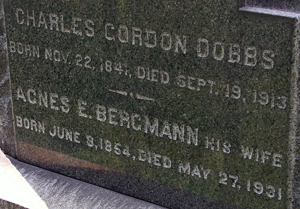
DOBBS, CHARLES GORDON (1841-1913). Sergeant, 22nd Regiment, New York State National Guard, Company F. Born in New York City and a clerk according to the census of 1860, he enlisted there on May 28, 1862, mustered into the 22nd Regiment that day, and mustered out after serving three months on September 5. As per the 1890 Veterans Schedule which verified his Civil War service, Dobbs returned to the same company and regiment in 1863 and served for 30 days from June 18 through July 24.
The census of 1870 and the 1875-1876 and 1877 New York City Directories list Dobs as a clerk in a store; he was a merchant as indicated by the census of 1880. At the time he applied for a passport in 1892, he was 5′ 10½” tall with dark brown eyes, brown hair, a dark complexion, high forehead and a straight nose. Remaining active in military affairs, he was a member of the James Monroe Post #607 of the G.A.R., and served as its commander in 1893. The census of 1900 states that he was president of the Eradeline Chemical Company at 123 Liberty Street in Manhattan (which dissolved in 1908). In 1907, he received an invalid pension, certificate 1,138,962. As per the census of 1910, he was employed as a bank broker. Dobbs’s obituary in the New York Herald notes that he was a member of the brokerage firm of Samuel White & Company at 59 Wall Street and a trustee of the Union Dime Savings Bank. His last address was 298 West End Avenue in Manhattan. His obituary in the New York Herald notes than he died suddenly at home. The cause of his death is listed as “gastric dilatation.” Agnes Bergmann Dobbs, who is interred with him, received a widow’s pension in 1913, certificate 774,048. Section 181, lot 17297.
DOBIECKI (or DOBICEKI, DOBIECKE), JOSEPH A. (1843-1863). Private, 131st New York Infantry, Company C. Originally interred at Green-Wood, he was removed from the cemetery on November 14, 1879. Dobiecki, a native of New York and a moulder (maker of molds for casting) by trade, enlisted as a private on August 16, 1862, at Brooklyn, and mustered into the 131st on September 6. As per the muster roll, he was 5′ 4″ tall with grey eyes, brown hair and a light complexion. He was wounded at Irish Bend, Louisiana, on April 13, 1863, and died on August 15 of his wounds at New Orleans Hospital.
DOBROWSKY, HENRY (1828-1881). Private, 1st New York Cavalry, Company L. Originally from Poland, Dobrowsky enlisted at New York City as a private on July 1, 1861, mustered into the 1st New York Cavalry on August 22, and was discharged on December 20, 1862, at North Mountain, West Virginia. In 1876, he applied for and was granted an invalid pension, certificate 142,824.
According to the Brooklyn Directory of 1873, he was in the liquor business at 307 Atlantic Avenue in Brooklyn. His last address was 307 Atlantic Avenue. He died of Bright’s disease. Mary Dobrowsky, his wife, was awarded a widow’s pension in 1881, certificate 204,259. As per the Brooklyn Directory of 1883, she continued his liquor business at the same address. Section 2, lot 5499, grave 1257.
DODD, JAMES (1827-1875). Captain, 15th New York Engineers, Company K; acting third assistant engineer, United States Navy. Born in Ireland, Dodd enlisted on June 17, 1861, at Willets Point, New York, as a captain, was commissioned into the 15th Engineers on that date, and resigned on November 11, 1861. His pension record indicates additional service in the Navy as an acting third assistant engineer. Further details are unknown. His last residence was 27 Grand Street in Manhattan. His death was attributed to a fractured skull. In 1879, his wife applied for and received a widow’s pension, certificate 919,534. Section 17, lot 17245, grave 1799.
DODD, PETER F. (1818-1872). Sergeant, 173rd New York Infantry, Company E. Dodd’s birthplace was the Isle of Guernsey. At the time of the 1850 census, he was living in Hempstead, New York; as per the census of 1860, he had moved to Williamsburg, and was a painter. The 1863 Brooklyn Directory lists him as a painter living at 150 South 2nd Street.
After enlisting as a corporal at Brooklyn on September 25, 1862, he mustered into the 173rd New York on October 30, and was promoted to sergeant on November 15, 1863. His muster roll confirms that he was a painter and records that he was 5′ 7″ tall with grey eyes and a dark complexion. Taken as a prisoner at Pleasant Hill, Louisiana, on April 9, 1864, he was paroled on May 27, 1865. According to the 1870 census, he had returned to work as a painter and his personal worth was $500. Dodd’s death was caused by sun stroke. In 1890, Elizabeth Dodd applied for and was granted a widow’s pension under certificate 300,020. Section 17, lot 17245, grave 1407.

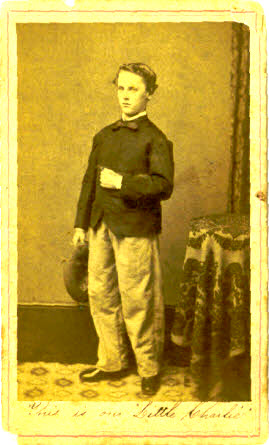
DODGE, JR., CHARLES J. (1842-1874). Sergeant, 53rd New York Infantry, Company F; 132nd New York Infantry, Company C. He enlisted as a sergeant and mustered into the 53rd at New York City on May 22, 1862. On September 10, 1862, he transferred to the 132nd New York, Company C, when the regiments were consolidated. He was reduced to ranks at some point. The regiment, part of Spinola’s Brigade and known as the Hillhouse Light Guards, fought at such sites as New Berne, Batchelder’s Creek and Jackson’s Mills, North Carolina. As per his muster roll, he was detached to duty with the Ambulance Corps in April 1863. Dodge was discharged on May 25, 1865, at Salisbury, North Carolina.
A resident of Greenpoint, Brooklyn, he earned his livelihood as a ship carpenter as per the census of 1870. The 1873-1876 Brooklyn Directory reports that he lived at 168 South 2nd Street. He last lived at 136 Kent Avenue in Brooklyn. His death was caused by consumption. His wife, Rosa Dodge, applied for a widow’s pension in 1876, application 228,135, but there is no evidence that it was granted. Section 45, lot 5931.
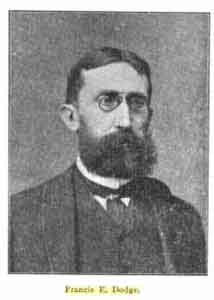
DODGE, FRANCIS EDWARD (1841-1926). Rank unknown, New York City Guard. A native of New York City, Dodge joined the City Guard in 1864. The City Guard was the name familiarly given to the 9th New York State Militia which later was consolidated into the 83rd New York. No other details are available.
After the Civil War, he attended functions of the 23rd Regiment but his relationship to that unit is not specified. As per the 1866 Brooklyn Directory, he was in the drug business at 88 William Street in New York City and living ay 80 Clinton Street in Brooklyn. His first wife, Matilda Cumming Dodge, died in 1872; they had two daughters, both of whom died in 1872, one at age five, the other at four. As per his obituary in The New York Times, he was a partner in the essential oil house of Dodge & Olcott for more than fifty years and an officer in the corporation that succeeded it; essential oils are used in cosmetics, perfumes and drugs. On February 29, 1899, The New York Times reported that Dodge attended a reception and meeting of the Chamber of Commerce that focused on the China trade and which featured an address by Rear Admiral Lord Charles Beresford of England.
Dodge was treasurer of the Long Island College Hospital and the New York Port Society. He also was a director of the Academy of Music and the Brooklyn Riding and Driving Club and a member of the Crescent Athletic, Hamilton and Montauk clubs. He last lived at 1148 Fifth Avenue in Manhattan but died at his summer home, the Thomas B. Halsey estate in Rumson, New Jersey. He died of chronic myocarditis. He was survived by his second wife, Magdalen née Talmage, and three children. Section 184, lot 24272.
DODGE, SEWELL ADDISON (enlisted as DAVIS, JOHN) (1835-1875). Second lieutenant, 27th Connecticut Infantry, Company D. Dodge was born in New York City. A New York resident using the name of John Davis, he enlisted as a first sergeant at New Haven, Connecticut, on September 10, 1862, and mustered into Company D of the 27th Connecticut on October 22. He was over 6′ tall and weighed about 200 pounds when he enrolled. His regiment was stationed at Washington, D.C., until November of 1862, and then moved into Virginia where it fought at Falmouth on November 7-19, 1862; Fredericksburg on December 12-15; Chancellorsville on May 1-5, 1863; and then at Gettysburg, Pennsylvania, on July 1-3, 1863. He was promoted to second lieutenant on May 17, 1863, and mustered out on July 27, 1863, at New Haven.
The 1875-1876 New York City Directory reports that Dodge was a superintendent at 583 Hudson Street living at 5 Leroy Street, his last address. As per his obituary in the New York Tribune, Dodge was the superintendent of Station C of the Post Office and a Freemason whose comrades were invited to attend his funeral. His death certificate confirms that he was employed by the New York Post Office. His last address was 5 Leroy Street, New York City. His cause of death was attributed to paralysis. Louisa M. Dodge, his widow, received a pension in 1880, certificate 279,415. The physician’s affidavit, which is held by Dodge’s descendant and was submitted in support of her pension claim, detailed Dodge’s deteriorating health following his discharge as due to chronic diarrhea from “exposure and lying upon the damp ground,” and noted that he developed symptoms of ulcerative disease and gradual paralysis of his left side. At the time of her death on July 3, 1908, Dodge’s widow was receiving a pension of $12.00 per month. Section 61, lot 2163.
DODWORTH, HARVEY B. (1822-1891). Bandleader, 71st Regiment, New York State National Guard. Born in Sheffield, England, into a family of musicians, his family immigrated to New York City when he was four years old. A year later, he was performing in public, playing the flute, and was soon proficient on the trombone, trumpet, and violin. At age 10, he played the piccolo in the orchestra at the Park Theater in New York City. In 1839, he became the leader of Dodworth’s Brass Band, which his father, Thomas, had founded soon after the family’s arrival from England. This was the first band composed of white men in New York City; all previous bands there were made up of black men. Over the years he and his band furnished the regimental music for the 7th, 8th, 9th, 12th, 13th, 22nd, 55th, and 71st New York National Guard regiments. He was the first person in the United States to arrange Richard Wagner’s music for military bands.
Most closely associated with the 71st National Guard, he led a fife and drum corps that accompanied Colonel Vosburgh (see) and the 71st at Bull Run, Virginia. There, with his men, he served as a scout and treated the wounded. It was the Dodworths who had their brass instruments redesigned so the bells pointed backward over the shoulders of the band members and their music could be heard by those who followed behind them. Harvey Dodworth and his brother, Allen, patented this horn design in 1838, it became known as the “backard blaster.”
He organized the first public concert held in Central Park and was featured at public events in New York City for half a century. He wrote several books of instruction for the coronet, manufactured brass instruments, sold sheet music, arranged music for bands and orchestras, and was one of the founders of the Philharmonic Society. One critic wrote, “…brass instruments were never played with greater delicacy or refinement than by the Dodworth organization…to be a member of this organization or to be graduated from it was to be looked upon as a star in the profession.” On September 6, 1870, the Brooklyn Daily Eagle noted that Dodworth’s “Excellent Orchestra” was performing in the last of the Summer Evening Concerts at the Rink; admission was 5 cents. The Brooklyn Daily Union reported on May 25, 1871, that Dodworth conducted the Brooklyn Choral Union at the Grand Musical Festival at the Brooklyn Skating Rink; he composed a choral overture for that occasion.
The 1875-1876 New York City Directory notes that he was a musician at 23 Union Square living on Washington Avenue and West 168th Street. The Veterans Schedule of 1890 for New Jersey confirms his service in the Civil War. According to the 1891-1892 New York City Directory, Dodworth was a musician at 47 Lafayette Place living at the same address in Washington Heights. He was also a Freemason. As per his obituary in the Brooklyn Daily Eagle, he was well-known in Brooklyn and was a band leader at Niblo’s and Daly’s theaters. His death certificate records that was a musician who died at 22 Hill Street in West Hoboken, New Jersey. The cause of death was paralysis. In 1891, Charlotte Dodworth, who is interred with him, applied for and received a widow’s pension, certificate 359,658. He was also survived by three sons. In 1892, the New York Clipper Almanac recorded his death in West Hoboken and identified his occupation as a band leader. Section 74, lot 10151.
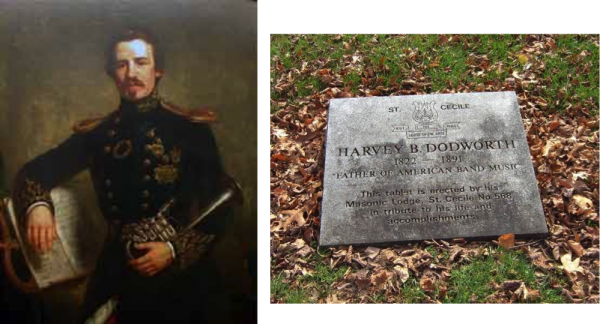
DOEHLER (or DOEHLE), CHARLES G. (1825-1895). Private, 29th New York Light Artillery; 32nd Independent Light Artillery. Born in Saxony, Germany, and a clerk at the time of his enlistment, Doehler’s muster roll notes that he was 5′ 7″ tall with grey eyes, brown hair and a fair complexion. After enlisting as a private on March 7, 1864, at New York City, he mustered into the 29th Light Artillery on the same date. He had subsequent service in the 32nd Light Artillery to which officers and men from the 29th Light Artillery were transferred in, en masse, in August 1864. He mustered out at New York City on July 12, 1865.
As per the 1870 and 1879 New York City Directories and the 1880 census, he was an upholsterer by trade working at 446 Sixth Avenue in Manhattan. The 1885-1886 Brooklyn Directory and the 1891-1892 New York City Directory note that he was still working as an upholsterer on Sixth Avenue and was living at 307 West 31st Street, his last address. As per his obituary in the New York Herald, he died suddenly; friends and relatives were invited to attend his funeral at his late residence. His last address was 654 8th Avenue in Manhattan. His death was due to heart disease. Section B, lot 11005, grave 77.
DOERGE, GUSTAVE (or GUSTAV) A. (1836-1891). Commissary sergeant, 7th New York Infantry, Company F. A native of Germany, Doerge immigrated to the United States in 1857. At the onset of the Civil War, he enlisted as a private at New York City on April 23, 1861, and mustered into Company F of the 7th New York that same day. On October 1, 1861, he was promoted to corporal of his company and then on September 28, 1862, he rose to commissary sergeant at which time he transferred into the regiment’s Field and Staff. He mustered out on May 8, 1863, at New York City.
On October 15, 1867, Doerge became a naturalized citizen. According to the New York City Directories for 1876, 1877, 1879 and 1880, he worked for a beer brewery. The 1882 Phillips’ Business Directory lists his name under the heading of “Wines and Liquors- Retail” at 7 Third Avenue. In 1889-1890, he was employed at an “eating house.” As per his 1889 passport application,, he was 5′ 7½” tall with a full face, blue eyes, blond hair, a healthy complexion and a broad forehead. In 1890, his application for an invalid pension was granted, certificate 588,284. The Veterans Schedule of 1890 confirms his Civil War service. The 1891-1892 New York City Directory notes that Doerge was in the beer business at 7 Third Avenue. His last residence was 165 3rd Street in Brooklyn. Section, lot 17263, grave 416.
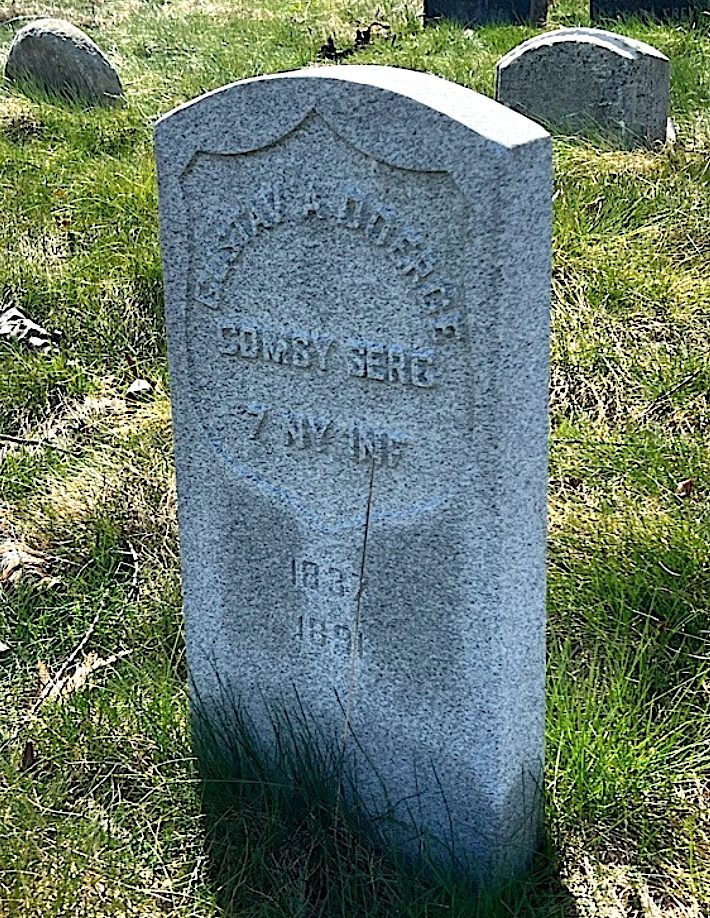
DOERING (or DORING), PHILIP (1827-1890). Captain, 54th New York Infantry, Company H. Of German birth, Doering enlisted as a captain on September 28, 1861, at Hudson, New Jersey, and was commissioned into the 54th New York that day although the official date of the promotion was January 4, 1862. He was discharged on February 2, 1862. In 1873, his application for an invalid pension was approved, certificate 127,486. According to the 1880 census, he was an officer at the Custom House. His last residence was 794 Myrtle Avenue in Brooklyn. The cause of his death was heart disease. Elizabeth Doering, received a widow’s pension, certificate 357,910. Section K, lot 1874.
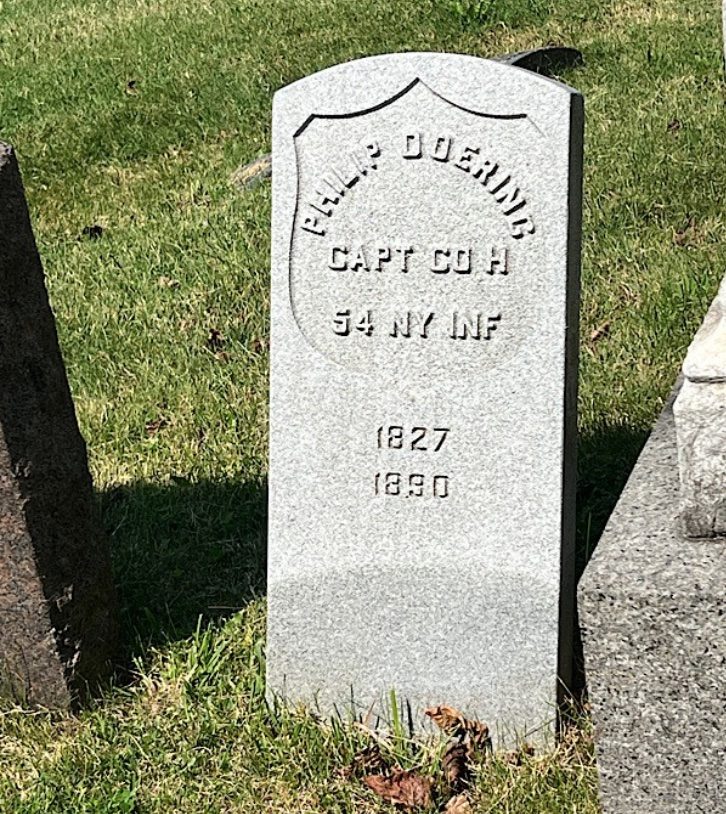
DOIG, ALEXANDER THOMAS (1822-1869). Acting first assistant engineer, United States Navy. Originally from Scotland, he immigrated to Orange County in 1847, and then relocated to Brooklyn in 1858. The Brooklyn Directory for 1860 notes that he was an engineer living at 414 Hicks Street at that time. Doig entered the Navy as an acting first assistant engineer on November 25, 1861. He sailed from Boston, Massachusetts, on the USS Mercedita on September 13, 1862, and was listed as an officer on that ship. The vessel was part of the South Atlantic Blockading Squadron. On January 31, 1863, he wrote to headquarters to report damage at Port Royal, South Carolina.
Sir: I respectfully beg leave to report the damage done to the boilers and machinery during the action of this morning and the present condition of same.
The enemy’s shell penetrated the engine-room bulkhead on the starboard side about 5 feet abaft the steam chimney, striking the port one and carrying away at least 4 feet of the outer shell.
The steam immediately escaped from the boilers and filled the engine and fire rooms, thereby leaving the machinery in a useless condition.
On examination of the starboard boiler I found that by closing the connections steam might be raised on it sufficiently to work the engine at a slow rate, which was done, in obedience to your orders.
It will require a further examination before I shall be able to report on the present condition of the boilers, to make which the coal must be removed from the side bunkers.
I am, very respectfully, your obedient servant,
A. Doig, Senior Engineer
Captain Henry S. Stellwagen, U.S.S. Mercedita.
He resigned on June 6, 1863. In 1865, he was listed on documents as a naturalized citizen. The 1863, 1864, 1865, 1866 and 1867-1870 Brooklyn Directories list him as an engineer; the 1868 Brooklyn Directory identifies him as a machinist living at 406 Hicks Street in Brooklyn, his last address. His last residence was at 406 Hicks in Brooklyn. His death was attributed to heart disease.
Initially placed in a receiving tomb on April 18, 1869, because of frozen ground, his body was moved to its present location on May 19. His widow, Mary Doig, had property worth $9,000 and a personal estate of $1,000 in 1870. Her will, dated June 11, 1873, left all her possessions to their daughter. She wrote that she did not make this decision “out of any ill will or want of proper maternal affection towards my two sons but from a consideration of her sex, her unmarried condition, her not having been brought up to any trade, the dangers and temptations to which she would in consequence otherwise be exposed.” She bequeathed the lot at Green-Wood to all of her children. Section 9, lot 18693.
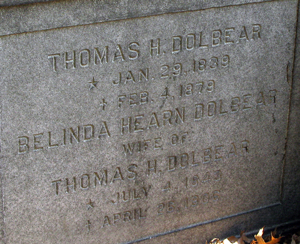
DOLBEAR (or DOLBIER), THOMAS H. (1839-1879). Private, 7th Regiment, New York State National Guard, Company D. Born in New York State, the 1850 census reports that he lived in the 9th Ward of New York City with his parents and sister. A teacher as per the census of 1860, he enlisted as a private at New York City on May 25, 1862, and served with the 7th Regiment when it was activated for three months that year.
On December 5, 1866, Dolbear married Belinda Hearn. The census of 1870 indicates that he was in college; the 1875-1876 and 1876-1878 New York City Directories list him as a teacher living at 21 West 50th Street in Manhattan. Dolbear died at the Bloomingdale Asylum in New York City. The cause of his death was dementia. As per his obituary in The New York Times, friends and relatives were invited to attend his funeral at the home of James Hearn, his father-in-law, at 718 Madison Avenue in Manhattan. He was survived by his wife and three daughters. Section 149, lot 15751.
DOLPHIN, MATHEW (or MATTHEW) JEROME (1839-1909). Private, 69th Regiment, New York State Militia, Company K. A native of Ireland, he enlisted and served for three months in the 69th New York State Militia in 1861. The 1873-1876 Brooklyn Directory lists him as a lawyer and the 1876-1878 New York City Directory notes that he worked at the Customs House. He is listed as a lawyer in the Brooklyn Directories for 1890-1892 and 1894-1896. Notably, Dolphin invented a stamp canceling machine that was used in post offices throughout the United States and was president of the International Postal Supply Company at 150 Nassau Street in Manhattan.
On March 27, 1895, The New York Times reported that Attorney General Hancock held a hearing on the behalf of stockholders who desired to remove Dolphin from office, alleging malfeasance and technical violations of laws governing corporations in New York State. Dolphin denied the charges and intimated that the petitioner, G. W. Hey of Syracuse, and others were taking this action to compel Dolphin to purchase their holdings. Decision was reserved. At the time of the hearing, the International Postal Supply Company had capital of $2,000,000. Dolphin was listed as having two patents in the 1896 Annual Report of the Commissioner of Patents. The 1902 and 1906 New York City Directories list him as president of the International Postal Supply Company. He last lived at 276 Berkeley Place in Brooklyn. As per his obituaries in the New York Herald and Brooklyn Daily Eagle, his funeral took place at St. Francis Xavier’s Church at 6th Avenue and President Street in Brooklyn. Newspapers in Syracuse, New York, and Washington, D.C., were asked to print notices of his death. Section P, lot 32730.
DOMANSKI, LEWIS (or LOUIS) (1827-1879). Captain, 31st New York Infantry, Company C; first lieutenant, 58th New York Infantry, Company K. Originally from Poland, Domanski and other countrymen of the Polish Legion met in New York on May 15, 1861, as per an article in the New York Herald. The group wanted “…to fight for the glory and freedom of a nation for which our compatriots, Kosciusko bled, and Pulaski died.” He enlisted as a first lieutenant on May 27, 1861, and was immediately commissioned into Company C of the 31st New York. He was promoted to captain on February 15, 1862, and mustered out at New York City on June 4, 1863. Domanski re-enlisted as a private on March 2, 1864, and mustered immediately into the 58th New York. His muster roll for the 58th Regiment notes that he was a machinist who was 5′ 10″ tall with hazel eyes, dark hair and a dark complexion. He received promotions to corporal on October 23, 1864, to sergeant on December 1, and to first lieutenant on January 15, 1865, but did not muster in that rank. On June 30, 1865, he mustered out at Nashville, Tennessee. In 1874, he applied for and received an invalid pension, certificate 152,170. He last lived in New York City. Domanski died from phthisis. Section 15, lot 17263, grave 23914.
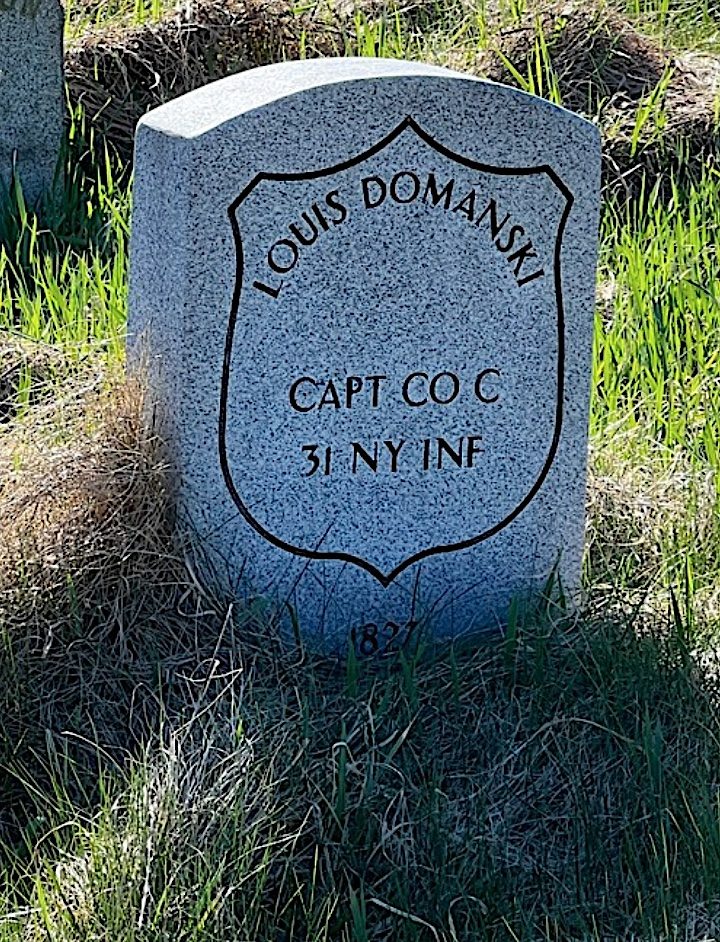
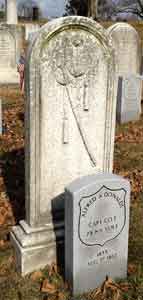
DONALDS (or DONALD), ALFRED A. (1833-1862). Captain, 73rd New York Infantry, Company F; first sergeant, 11th New York Infantry, Company I. According to the 1860 census, Donalds was a ship carpenter by trade. He enlisted on April 20, 1861, at New York City, as a first sergeant, and mustered into Company I of the 11th New York on May 7. He was discharged for promotion to captain on August 1, 1861, and was commissioned into the 73rd New York’s Company F on August 20. On May 7, 1862, the colonel of the 73rd, William R. Brewster (see), cited him and other captains for their assistance, “…in urging forward the men when exposed to a galling fire and obliged to advance through a thick entanglement of brush and felled timber. The most of my men were shot while climbing over felled trees.” In his field report dated July 7, 1862, Brigadier General Daniel Sickles, United States Army, wrote, “I must especially commend the admirable conduct of Capt[ain] Alfred A. Donalds, commanding Fourth Excelsior. He was not assisted by a single officer above the rank of lieutenant, and of these only four were on duty. Notwithstanding every embarrassment, the fragment of his brave command was most effectively and gallantly led by him throughout the day.” Reporting from the battlefield near Harrison’s Landing, Virginia, on July 14, 1862, Brigadier General Joseph Hooker, United States Army, praised Donalds for his meritorious services noting that his “heroic conduct was conspicuous throughout the day.”
A month later, Donalds was killed in action at Bristoe Station, Virginia, on August 27, 1862. His demise was noted by Captain M. William Burns of Company A who praised his valor and by the commanding officer Brigadier General Nelson Taylor, United States Army, who saluted him in his field account from Fort Lyon, Virginia, on September 8, “…In closing this report I shall avail myself of the opportunity to express my admiration of the gallant conduct on the field of the officers and men who so nobly followed the fortunes of the brigade during the time which this report covers, particularly to the lamented Captain Alfred A. Donalds, of the Fourth Excelsior Regiment, who fell early in the action at Bristoe Station…” He was interred at Green-Wood on November 23 of that year. Section 115, lot 13536 (Soldiers’ Lot), grave 23.
DONALDSON, ALONZO (or ALONZA) A. (1836-1910). Private, 37th Regiment, New York State National Guard, Company G. A New York native, the census of 1860 reports that he was a clerk and lived in New York City. According to his pension index card, he enlisted on June 18, 1863, mustered into the 37th Regiment, and mustered out with his company on July 22, 1863.
He is likely the Alonzo Donaldson who is listed in the 1875-1876 and 1877 New York City Directories as working in a tackle store on 7 Warren Street. As per the census of 1880, he was single, worked as a clerk, and lived in Monroe, New York. The New York State census of 1905 records that he lived in Brooklyn, was married and worked as a cordage clerk. He last lived in Vineland, New Jersey. Donaldson succumbed to pneumonia. In 1931, Susan Donaldson applied for a widow’s pension, application 1,701,520, but there is no evidence that it was certified. Section 20, lot 5599.
DONALDSON, EFFINGHAM (1840-1872). Major by brevet; captain, 6th New York Heavy Artillery, Companies M, G, and A; first lieutenant, 11th New York Infantry, Companies E and C; second lieutenant, 172nd New York Infantry; private, 7th Regiment, New York State Militia, Company G. A New Yorker by birth, his name appeared in an article in The New York Times on December 15, 1859, as one of the many New York area residents opposed to the actions of John Brown’s Raid and condemning the idea of an irreparable conflict between the sections of the country. He was listed as a clerk on the census of 1860.
Donaldson first served in the 7th Regiment when it was activated from April 19 through June 3, 1861. He re-enlisted at Newport News, Virginia, as a second lieutenant on September 26, 1861, was immediately commissioned into Company E of the 11th New York, was promoted to first lieutenant on February 18, 1862, effective upon his transfer to Company C that day, and mustered out at New York City on June 2, 1862. On November 20, 1862, he mustered into the 172nd New York as a second lieutenant, and transferred out soon thereafter on December 4. He then re-enlisted in the 6th New York Heavy Artillery, Company M, on an unstated date, was promoted to acting adjutant on April 1, 1863, and transferred that day to the regiment’s Field and Staff. Two months later on June 1, he was promoted to first lieutenant and transferred to Company G, and subsequently, was promoted to captain on April 25, 1864, effective upon his transfer to Company A on June 7. He fought in the following Virginia battles: Wapping Heights, Laurel Hill, Todd’s Tavern, Po River, Salient, Harris’s Farm, North Anna, Bethesda Church, Petersburg, and Cedar Creek. He was the assistant adjutant general for “Kitching’s Brigade” and received recognition by General Meade. Donaldson mustered out at Washington, D.C., on August 24, 1865. On January 29, 1866, he was brevetted major “for gallant and meritorious services.”
As per the Brooklyn Directory for 1869, he was a broker at 50 Wall Street in Manhattan. He is listed as a broker at the same Wall Street address in the 1867-1870 Brooklyn Directory; at that time, he lived at 200 Hamilton Avenue. He last resided in Elizabeth, New Jersey. Phthisis pulmonalis is listed as the cause of his death. Section 57, lot 2388.
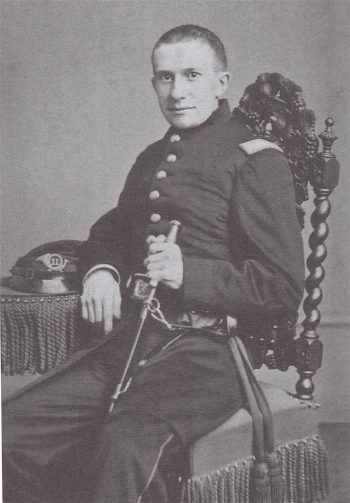
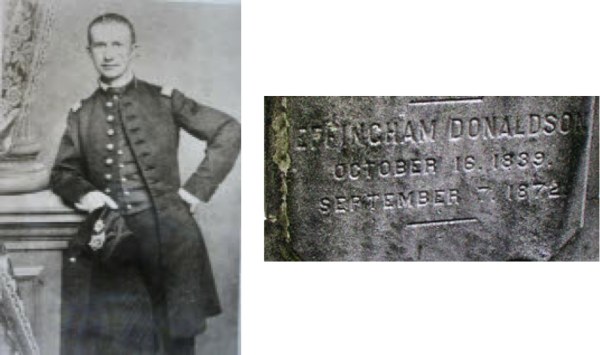
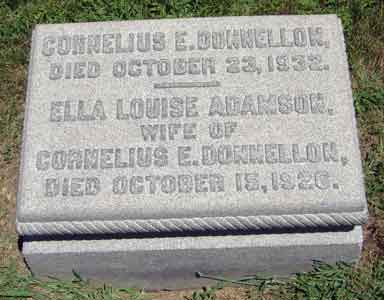
DONNELLON, CORNELIUS E. (1850-1932). Drummer boy, 15th Connecticut Infantry. Born in the Chelsea section of Manhattan, his family moved to Brooklyn where his father was a builder. As a youngster, Donnellon served as a drummer boy for the 15th Connecticut Infantry.
After the war, he first was employed in importing before joining his father’s building and real estate businesses. He became a prominent realtor and vice president of the Chauncey Real Estate Company at 207 Montague Street in downtown Brooklyn, a street he referred to as the “Wall Street of Brooklyn.” His work brought him to Flatbush, Bensonhurst, and Borough Park at a time when these Brooklyn neighborhoods transformed from farmlands into residential areas.
The Brooklyn City Directories for 1888 and 1890 list him as a builder at 116 Pacific Street. The 1890-1891 Brooklyn Directory reports that he was a merchant at 81 Beaver Street. On May 16, 1892, the Brooklyn Daily Eagle published a list of Brooklyn millionaires; Donnellon, who was listed as a builder and realtor, was on that list. As per the 1894-1896 Brooklyn Directory, he was a vice president at 207 Montague Street. The 1896-1898 Brooklyn Directories list him as a merchant at 81 Beaver Street and a realtor at 207 Montague Street; he lived during those years on Carroll Street.
On November 25, 1923, Donnellon noted that “activities in the Brooklyn real estate market had reached their peak”; he cited that plasterers were receiving the sum of $26 a day. The Brooklyn Standard Union reported on September 8, 1925, that Donnellon paid an additional income tax assessment of $2,451; all Brooklynites who paid more than $500 were listed in that news article.
Donnellon was active in civic life in his community and devoted time after retirement to his art collections and philanthropic endeavors. The Brooklyn City Directories for 1888 and 1890 list him as a builder at 116 Pacific Street. According to his obituary in The New York Times, he led a fight against politicians who wanted to franchise the Union Street trolley line without compensating the city. As part of that protest, he secured payment for property owners along Seventh Avenue in Brooklyn that were impacted by the new transit operation. He was the brother of Henry Donnellon (see). During the last 35 years of his life, he resided at 849 Carroll Street, Brooklyn. He died of cardiac arrest. A widower at the time of his death, his wife, Ella née Adamson, died in 1926; their child died in 1898. Section 146, lot 27097.
DONNELLON, HENRY RUXTON (1843-1914). Corporal, 8th Regiment, New York State Militia, Company C. A New York City native, he enlisted there as a corporal in 1861 for three months of duty, mustering out at the expiration of his term. The census of 1870 indicates that he was a builder; in the 1880 federal census, his occupation was listed as “real estate dealer.” The 1888 and 1890 Brooklyn Directories list him and his brother Cornelius (see) as builders at 116 Pacific Street. The Veterans Schedule of 1890 confirms his military service in the Civil War. The 1891-1892 and the 1896-1898 Brooklyn Directories list him as a realtor at 116 Pacific Street. In 1906, his pension application was approved, certificate 1,127,244. The census of 1910 lists his occupation as “real estate.” His last residence was 116 Pacific Street in Brooklyn. His death was caused by pneumonia. Section 146, lot 26335.
DOONAN, JAMES (1842-1898). Private, 10th New York Infantry, Company I; 5th Cavalry, United States Army, Company G. Born in Ireland, he enlisted as a private at New York City on an unknown date and mustered into the 10th New York from which he was discharged on November 2, 1862. On that same date, he re-enlisted and mustered into the 5th Cavalry, United States Army. His last address was 397 3rd Avenue in Manhattan. Doonan died of complications from a fracture. Section 15, lot 17263, grave 1583.

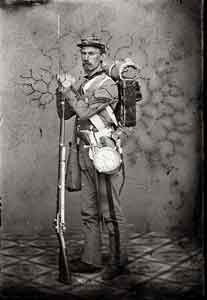
DORÉ, JOSEPH (1832-1902). Sergeant, 7th Regiment, New York State Militia, Company C. Doré, who was born in New York State, enlisted as a sergeant in 1861 and served for 30 days when the 7th Regiment’s State Militia was activated that year. As per an article about him in Military Images Magazine (2022), he left behind his wife, Mary, who was pregnant with the first of their three daughters, when the 7th was called to into service. He also served with that regiment and company when it was part of the New York State National Guard for three months in 1862 (May 30 through September 5) in the defense of Baltimore and then for 30 days in 1863. Doré continued his service with the 7th Regiment after the war, with the rank of second lieutenant in 1866 and first lieutenant in 1867.
As per the census of 1870, he was working as a clerk; the New York City Directory for 1876 indicates that he was in the shoe business. At the time he applied for a passport in 1873, Doré was 5′ 8½” tall with a high forehead, black eyes, black hair, dark complexion, full face, and prominent nose. The 1876-1878 New York City Directory indicates that he was in the shoe business at 85 Chambers Street and lived in New Jersey. According to the census of 1880, he was living in Jersey City, New Jersey, and working in the shoe and boot business; the New York City Directory for 1885 states that he was a shoe manufacturer at 854 Lexington Avenue. The 1876-1878 New York City Directory indicates that he was in the shoe business at 85 Chambers Street and lived in New Jersey. The census for 1900 reports that he was a bookkeeper living in Manhattan. At some point, he relocated to Florida where he was engaged in the lumber business.
As per his obituary in the New York Herald, newspapers in Florida were asked to post a notice of his death. His last residence was 445 West 43rd Street in Manhattan. He succumbed to nephritis. In 1905, his widow, Mary Doré, who is interred with him, received a pension, certificate 600,475. Section 190, lot 17725, grave 3.

DORECK, JOSEPH PETER (1828-1889). Corporal, 15th New York Engineers, Company B. A native of Mannheim in Baden, Germany, he enlisted as a private at New York City on May 9, 1861, and mustered into the 15th Engineers on June 17. A laborer, he was 6′ ½” tall with hazel eyes, brown hair and a dark complexion. On November 1, 1862, he was promoted to corporal and mustered out on June 25, 1863. On December 18, 1863, he re-enlisted at New York City as a private, returned to Company B of the 15th, was promoted to corporal on January 26, 1865, and was discharged on July 2, 1865, at Washington, D.C.
On October 13, 1868, Doreck became a naturalized citizen. In an article in the New York Herald reporting that boxes of cigars had been stolen from his delivery truck, he was identified as the truck’s owner. As per the 1875-1876 New York City Directory and the census of 1880, he was an expressman who picked up letters and parcels for quick delivery. The 1884-1885 New York City Directory identified him as a driver living at 1252 First Avenue. According to the New York City Directory for 1888, he was a laborer. In 1888, his application for an invalid pension was approved, certificate 438,142. His last residence was East 75th Street, Manhattan. He died from heart disease. Anna Doreck applied for and received a widow’s pension in 1889, certificate 257,222. In 1890, his widow confirmed Doreck’s service for the Veterans Census. Section 3, lot 21025, grave 469.
DOREMUS, ABRAHAM (or ABRAM) SNEDECKER (1846-1909). Sergeant, 6th United States Army, Company H. Doremus was born in New Rochelle, New York. As per his obituary in the Brooklyn Daily Eagle, he enlisted on December 16, 1864, and served in the 6th United States Infantry in New York City and South Carolina during the Civil War. At the time of his enlistment, he was a clerk with blue eyes and brown hair. He mustered out as a sergeant on December 16, 1867, at the completion of his three year term. Subsequently, he was veteran member of the 7th Regiment, New York National Guard.
As per the 1870 census, Doremus was a railroad conductor. He became a letter carrier on July 1, 1872, and, at the time of his death, had been assigned to carry the mail to the United States immigrant station at Ellis Island, a route that he held for ten years. As per the 1875-1876, 1876-1878, and 1882-1883 New York City Directories, he was a carrier. The 1890 Veterans Census confirms his Civil War service. The Brooklyn Directories for 1894-1896 and 1896-1898 identify him as a clerk. In 1901, he applied for and received an invalid pension, application 1,078,611. In May 1907, in commemoration of 35 years of service with the Post Office, Dennison was presented with a gold and diamond watch fob. He belonged to the Letter Carriers’ Association and the Mutual Benefit Association.
As per his obituary in the Brooklyn Daily Eagle, which confirms his Civil War service, he was a veteran member of the 7th Regiment, New York National Guard. Sophia Chichester Doremus, who is interred with him, applied for and received a widow’s pension, certificate 681,417. He was also survived by four sons. Section 76, lot 1918.

DOREMUS, ROBERT OGDEN (1824-1906). Analytical chemist, toxicologist, and inventor. Born in New York City, the son of Thomas C. Doremus (see) and Sarah Platt Haines Doremus (see), he graduated from Columbia College in 1842 and received his M.D. from the University of the City of New York in 1851. He was Professor John W. Draper’s (see) first private pupil, and assisted Draper in taking the first close-up photograph of a human face. Doremus perfected the arc-light and a process to generate oxygen for use in increasing the light given off by a coal gas flame. He became professor of chemistry at the New York College of Pharmacy in 1849 and helped to found the New York Medical College the next year. Using his own funds he there equipped one of the first analytical laboratories connected to a medical school in this country. He was a professor of chemistry and physics at the College of the City of New York 1852-1903 and also served as that school’s vice president. He was known at that school for his exciting lectures and the unique apparatus which he constructed for them.
Doremus spent 1862-1864 in Paris perfecting a compressed granulated gunpowder for firearms, which eliminated the need to sponge muzzle-loading cannon after firing and was used during the Civil War and the Franco-Prussian War. He also pioneered in the use of chlorine as a disinfectant, building an apparatus in 1862 which was used to pump chlorine gas into a steamer which arrived in New York with a cholera epidemic on board. His process was used again in 1875 against cholera in New York hospitals. His investigations in toxicology led to a revolution in the use of science in criminal prosecutions. His expert testimony was the determining factor in some of the most famous criminal trials in New York City. He was also an editor of the Standard Dictionary of chemistry and was responsible for all chemical definitions. He was a founder of the Philharmonic Society and its first president who was not a professional musician. Section 36, lot 13130.

DOREMUS, SARAH PLATT HAINES (1802-1877). Social activist. She was born to a well-to-do family in New York City. Her mother was deeply religious and from the age of ten, Sarah joined with her mother in praying for the conversion of the world, the beginning of a lifelong mission. At the age of nineteen, she married Thomas Cornelius Doremus. Despite the demands of raising nine children and adoptees, she was active in public affairs for fifty years. In an era when few women were so involved, she joined eight women to organize a relief mission to aid Greek revolutionaries in 1828, promoted the Baptist Mission of Grand Ligne in Canada beginning in 1835, helped the effort to maintain religious services in city prisons, and was a founder of a temporary shelter for women discharged from prison (what was to become the Isaac T. Hopper (see) Home, and which she served as president). She worked on pioneering efforts to help New York’s poor women, including the House and School of Industry (1850) and the Nursery and Child’s Hospital (1854). In 1855, when Dr. J. Marion Sims (see) was trying to establish a hospital to treat women, she was instrumental in obtaining legislative approval and in raising funds for the Woman’s Hospital. She became the first president of the Woman’s Hospital and remained its president until her death.
In 1860, Doremus was a founder of the Woman’s Union Missionary Society, an effort by Protestant women to improve the conditions of their sisters in non-Christian countries. Her efforts were also expended on ministering to the sick and wounded on both sides during the Civil War; she also distributed supplies among hospitals in New York City. In addition, she aided the victims of the Irish famine of 1869. Doremus’s last effort was on behalf of the Gould Memorial, a society that hoped to establish Italian-American schools. Her great contribution was her leadership in enlisting other women in social causes. Dedicated to her work, she returned an expensive shawl given to her by her husband; with the needlework and embroidery she received for the shawl, she sent $500 to missions in Hawaii. Known affectionately as “Mother of Missions,” she died after a fall. Section 36, lot 13130.
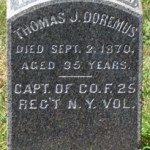
DOREMUS, THOMAS J. (1835-1870). Captain, 25th New York Infantry, Company F. Doremus enlisted at New York City as a captain on May 11, 1861, was commissioned into the 25th Infantry on June 13, 1861, and resigned on October 31, 1861. His last residence was in New York City. His death was attributed to consumption. Section 117, lot 10975, grave 129.
DORN, CHARLES (1832-1893). Private, 34th New York Infantry, Company A; rank unknown, United States Navy; private, 18th New York Cavalry. Of German birth, he is listed as a bootmaker in the 1857-1862 Brooklyn Directory; his business was at the corner of Concord and Gold Streets. During the Civil War, Dorn enlisted as a private on June 16, 1861, at Albany, New York, and mustered immediately into the 34th New York. On February 17, 1862, he was transferred into the United States Navy. Subsequently, he served in the 18th New York Cavalry.
The 1864, 1865, 1866 and 1868 Brooklyn Directories list Dorn as a shoemaker at 146 Concord Street. Catharine Donwolf Dorn, his wife, died in 1867; they had one son. As per the 1867-1870 Brooklyn Directory, he still worked at 146 Concord Street. The 1873-1876 Brooklyn Directory identifies him as a shoemaker living at 29 Maujer Street. He continued working as a shoemaker at 650 DeKalb Avenue at the time of the 1884-1886 Brooklyn Directory. His last residence was 152 Sumner Avenue in Brooklyn. His death was caused by nephritis. Section D, lot 7078, grave 340.
DORRANCE, GEORGE W. (1840-1866). Second lieutenant, 56th Regiment, New York State National Guard, Company I; private, 13th Regiment, New York State National Guard, Company F. Born in New York, Dorrance enlisted as a private at Brooklyn on May 26, 1862, and mustered into Company F of the 13th Regiment the same day. He mustered out at Brooklyn three months later on September 12. He re-enlisted at Brooklyn as a second lieutenant on June 18, 1863, and the same day was commissioned into Company I, 56th New York National Guard. He mustered out at Brooklyn after 30 days on July 24, 1863. As per the 1865 Brooklyn Directory, he was a clerk living at 94 Lawrence Street, his last address. Section 189, lot 17947.
DOSCHER, JOHN H. W. (1840-1925). Corporal, 28th Regiment, New York State National Guard, Company K. Doscher, who was born in Germany, served when the 28th Regiment was activated for 30 days in 1863. As per his obituary in the Brooklyn Standard Union, he settled in New York City in 1861 and, for forty years, was in the grocery business. John H. W. Doscher is listed as a grocer in the 1876-1878 and 1884-1885 New York City Directories; his establishment was located on Broome Street. He lived in South Brooklyn the last 35 years of his life and, for 20 years, had a wine room at 396 Seventh Avenue.
His obituary notes that he was at one time a member of the Third Cavalry, New York State National Guard. In addition, Doscher was a vice president of the board of trustees of St. John’s Lutheran Church and a member of the Lamstedter Society, a German social club. His last residence was 396 Seventh Avenue in Brooklyn. The cause of his death was “carditis.” He was survived by two daughters and a son. Section 137, lot 28689.
DOSE, FREDERICK K. (1845-1908). Private, 31st New York Light Artillery; 30th New York Light Artillery. Of German birth, Dose immigrated to the United States when he was thirteen. During the Civil War, he enlisted as a private at Brooklyn on April 4, 1864, and mustered immediately into the 31st Light Artillery. He transferred into the 30th New York Light Artillery on October 25, 1864, and mustered out at New York City on June 23, 1865.
After the war, as per his obituary in the Brooklyn Daily Eagle, Dose was an importer of French china and a well-regarded member if the Crockery Board of Trade. The 1873-1876 Brooklyn Directory identifies him as being in the crockery business at 35 & 37 Park Place in Manhattan and living at 137 Clinton Avenue in Brooklyn. Dose is listed in the 1884-1886 Brooklyn Directory as being in the china business at 43 Barclay Street and still living at same residence on Clinton Street. As per the 1890-1892 Brooklyn Directory, he was an importer at 43 Barclay Street in Manhattan; during those years, he lived at 1432 Macon Street in Brooklyn. The New York Herald reported on July 27, 1894, that Dose was among the Americans who registered at that newspaper’s office in Paris. In addition, he was a member of St. Luke’s German Lutheran Church on Washington Avenue in Brooklyn. His last residence was 329 McDonough Street in Brooklyn. His death was caused by pneumonia. He was survived by his wife, two sons and a daughter. Section 91, lot 1440.

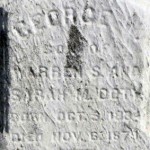
DOTY, GEORGE WASHINGTON (1834-1879). Unknown soldier history. A family history, The Doty-Doten Family in America, written by George’s brother Ethan Allen Doty (published in 1989), notes that George Doty was a clerk who served in the War of the Rebellion but gives no details on his service. The family’s history dates back to the Mayflower. The Doty family was well-known in Brooklyn, the site of its paper-manufacturing business at 407 Willoughby Avenue known as Doty & Bergen (1844), Doty & McFarlane (1862), and then as of 1889, as Doty & Scrimgeour. The business, which began in 1844, was the subject of an article in the Brooklyn Daily Eagle which described how fancy colored paper was manufactured and detailed the history of the Doty family’s connections to the enterprise. He last lived in Brooklyn. His death was attributed to convulsions. Section 66, lot 3266.
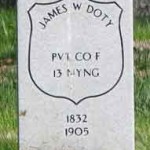
DOTY, JAMES W. (1832-1905). Private, 13th Regiment, New York State National Guard, Company F. Born in Albany, New York, J. W. Doty is listed in the 1857-1862 Brooklyn Directory as a grocer at 422 Fulton Avenue; during those years, he lived at 9 St. Felix Street. During the Civil War, he enlisted as a private at Brooklyn on May 26, 1862, mustered into the 13th New York on that day, and mustered out at Brooklyn after three months on September 12.
The 1862, 1866 and 1876 Brooklyn Directories note that he was a grocer; the 1880 census states that he was a retail grocer. Doty is identified in the 1880-1882 Brooklyn Directory as a retail grocer at 466 Atlantic Avenue. His service is confirmed by the 1890 Veterans Census. In 1896, he applied for and received an invalid pension, certificate 920,954. Doty last resided at 20 Clinton Street in Brooklyn. His death was caused by valvular disease. Section 203, lot 28732.
DOUGHERTY, SAMUEL (1835-1868). Hospital steward, 56th Regiment, New York State National Guard. Dougherty, a native of New Jersey, served as a hospital steward for 30 days with the 56th Regiment (company unknown) when it was activated in 1863. He last lived at 20 Portland Street in Brooklyn. Section A, lot 16610, grave 65.
DOUGHTY, GARDNER K. (1835-1908). Sergeant, 48th New York Infantry, Company A; 7th Regiment, New York State Militia, Company I. A native New Yorker, standing 5′ 9″ tall and weighing 125 pounds, with dark hair and eyes, Doughty first served in the 7th Regiment from April 19 until June 3, 1861. He then re-enlisted at Brooklyn as a corporal on December 2, 1861, mustering into Company A of the 48th New York. He was promoted to sergeant (date not given) and was wounded in both shoulders by the same shell at the Battle of Drewry’s Bluff, Virginia, on May 16, 1864. According to the surgeon’s certificate, the shell left two scars, the one on the right side, where it entered, the size of a silver dollar, the one on the left, where it exited, the size of a 50 cent piece. After being treated for his wounds at Hampton General Hospital at Fortress Monroe, Virginia, Doughty reported back for duty at Headquarters, Department of the East, on July 15, 1864. He served in South Carolina, Georgia, Florida, and Virginia with the 10th Corps before he mustered out with his regiment on December 1, 1864.
Remaining active in military affairs, he belonged to the G.A.R.’s Ulysses S. Grant Post # 327. In 1872, his application for an invalid pension was granted under certificate 118,436. As per the census of 1880, he was a lumber clerk; the New York City Directory of 1886 lists him as a clerk. The census of 1900 records his occupation as collector. His last address was 532 Putnam Avenue, Brooklyn. Doughty died from nephritis. Margaret A. Doughty, applied for and received a widow’s pension in 1908, certificate 654,227. Section 28, lot 9815.

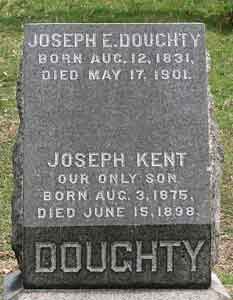
DOUGHTY, JOSEPH E. (1831-1901). Sergeant, United States Signal Corps; corporal, 132nd New York Infantry, Company F. A native of New York City and a printer by trade, Doughty enlisted there as a corporal on August 11, 1862, and mustered into Company F of the 132nd New York on October 4. As per his muster roll, he was 5′ 9½” tall with mixed hair, blue eyes and a fair complexion. On July 28, 1863, he was transferred into the Signal Corps at Fort Monroe, Virginia, where he remained until completion of his term of service (date unknown).
According to the census of 1870, Doughty was living in Norfolk, Virginia, and worked there as a printer. He then moved back to New York City; its 1876-1878 Directory indicates that he was a printer, as do the censuses of 1880 and 1900. The Veterans Schedule of 1890 confirms his military service as a sergeant in the Signal Corps. As per the 1890-1892 New York City Directory, Doughty was still working as a printer; at that time, he was living at 840 West 11th Street. His last residence was at 197 West 12th Street in Manhattan. He succumbed to nephritis. Margaret E. Doughty, who is interred with him, received a widow’s pension in 1901, certificate 553,625. Section 40, lot 6219, grave 6.
DOUGHTY, THOMAS (1824-1865). Corporal, 139th New York Infantry, Company D. Born in Philadelphia, Pennsylvania, he was likely the son of the artist of the same name, a landscape painter whose work led to the founding of the Hudson River School. That Thomas Doughty also is interred at Green-Wood. According to this soldier’s obituary in The New York Times, he was a corporal who served in the 139th New York. He enlisted on August 20, 1862, died from chronic diarrhea at David’s Island, New York Harbor, on July 24, 1865, and was buried at Green-Wood three days later. On August 12, 1865, Sarah Doughty, his mother, applied for a pension that was granted under certificate 113,098. Section 167, lot 16250, grave 384.
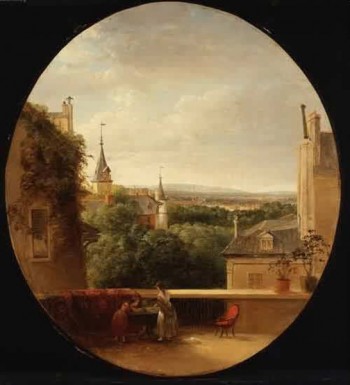
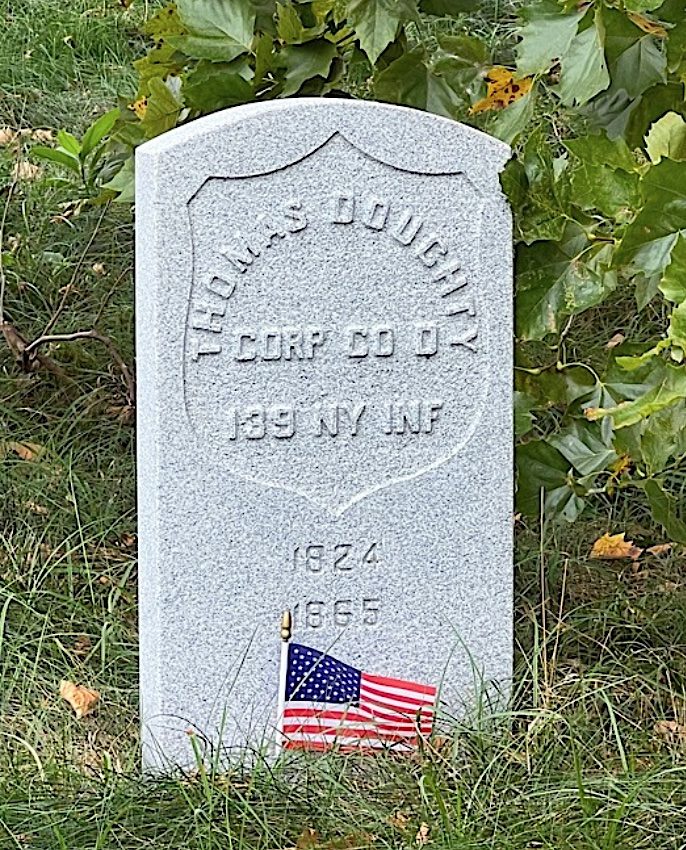
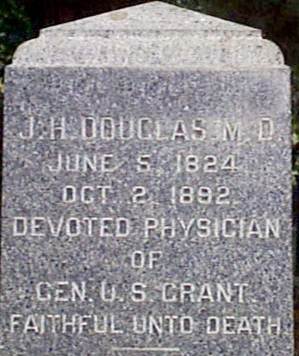
DOUGLAS, JOHN HANCOCK (1824-1892). Physician to General Ulysses S. Grant and Sanitary Commission volunteer and reporter. Born in Waterford, New York, Douglas graduated from Williams College in 1843 and completed his medical studies at the University of Pennsylvania in 1847. From 1849 through 1851, he traveled and studied in Europe, and also returned abroad in 1854. He practiced medicine in New York City from 1856 to 1862, while also editing twelve volumes of the American Medical Monthly. An inspector for the United States Sanitary Commission during the Civil War, he reported and authored documents from the Battle of Fredericksburg, Virginia, December 13, 1862, and the Battle of Gettysburg, Pennsylvania, July 1-3, 1863. It was during the War when he first met General Ulysses S. Grant at Fort Donelson, Tennessee in 1862. The Sanitary Commission was charged with improving the medical care of soldiers and Douglas became associate secretary for the Commission’s activities west of the Mississippi, where General Grant was in command. According to one account, Douglas was credited with using pickles and sauerkraut to prevent scurvy.
In New York City from 1865 to 1868, he edited three volumes of the New York Medical Journal and wrote articles for other professional journals including the New Orleans Medical and Surgical Journal, the New Orleans Hospital Gazette, the Boston Medical and Surgical Journal. On June 10, 1873, he married Josephine Curtis Stratton, a widow; the couple had two daughters. He was among the first members of the American Laryngological Association and the New York Academy of Medicine. When Grant was diagnosed with throat cancer in 1884, Douglas, a throat specialist, served as his personal physician until his death, ministering to him almost every day, and near the end, twenty-four hours a day, forcing him to abandon his practice to care for Grant. Douglas’s treatment choices, particularly his use of cocaine, were questioned.
In 1885, when Douglas returned to his practice after Grant’s death, he found it hard to rebuild his clientele. He suffered from financial trouble and spent his last years in poor health, was expelled from the Laryngological Association (presumably for non-payment of $5 dues), and in need of charity. The 1885-1886 Brooklyn Directory and 1891-1892 New York City Directory lists him as a physician; at the time of the latter directory, he was living at 48 East 98th Street. His tombstone is inscribed, “Devoted physician of Gen. U.S. Grant, Faithful Unto Death.” In January 2009, The Laryngoscope, a professional journal, published “The Magnanimous Professional Life and Tragic Demise of J. H. Douglas, MD.,” concluding that his outstanding career came to an unjust end when he was stripped of his membership in the Laryngological Association. Section 44, lot 2574.
DOUGLAS (or DOUGLASS), WILLIAM (1833-1873). Sergeant, 178th New York Infantry, Company A. A native of Ireland, Douglas enlisted as a private at New York City on June 3, 1863, and mustered into the 178th New York on June 18. On August 31, 1864, he was promoted to corporal of his company and subsequently became its sergeant two months later on October 31. He was reduced in rank to private on December 31, 1864, but returned to his company as a corporal on January 11, 1865. On December 15, 1865, he was again reduced in rank to private remaining in that rank when he mustered out on April 20, 1866, at Montgomery, Alabama. His last residence was on 22nd Street in Brooklyn. His death was attributed to phthisis. Section B, lot 8575, grave 942.

DOUGLASS (or DOUGLAS), GEORGE (1830-1883). Second lieutenant, 47th New York Infantry, Company C. A New Yorker by birth, he enlisted there as a first sergeant on May 17, 1861, mustered in on August 7, 1861, was promoted to second lieutenant on January 2, 1864, but was not mustered, and was discharged on August 8, 1864. His last home was at 509 West 42nd Street in Manhattan. Douglass died of pneumonia. He may be a relative of John T. Douglass (see) who is buried in the same lot. Section 14, lot 4969, grave 289.

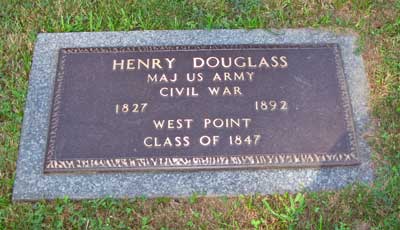
DOUGLASS, HENRY (1827-1892). Major by brevet; captain, 18th Infantry, United States Army. Born in West Point, New York, he was the son of David Bates Douglass, who taught there and designed Green-Wood Cemetery. Douglass was graduated from West Point in 1852, number 31 in his class. Upon graduation and assigned to frontier duty, he was brevetted second lieutenant, 7th United States Infantry, in 1852, served in the 8th Infantry in 1853, and in the 9th Infantry in 1855. He was promoted to first lieutenant in 1856.
In 1858, Douglass married Isadore Bowman. Returning to West Point, he was an assistant professor until 1861, when he was promoted to captain and joined the 18th Infantry in May. He fought at First Bull Run, Virginia, and was wounded at Stone River, Tennessee, where he commanded a battalion. On December 31, 1862, he was brevetted to major for his gallantry and meritorious service at the Battle of Murfreesboro, Tennessee. On February 18, 1863, Colonel O. H. Stone, United States Army, cited him in his report from Murfreesboro:
“…He was commander of the First Battalion from its organization, in the fall of 1861, and continued so through all the trying campaign of Mill Springs, up to May 26, 1862, just before entering Corinth, and has ever since been acting field officer. In the performance of said duty he was distinguished in the battle of Perryville, and wounded in the great battle of Stone’s River, during the heavy conflict in the cedars, on December 31, 1862. Having his wound dressed, and with his arm in a sling, he reported for duty as the brigade moved to the front, January 2, but was directed shortly after to go again to the hospital. He has always been brave and zealous, and is again in command of his battalion, which owes much of its instruction to him…”
After the Civil War, Douglass returned to frontier duty. He was promoted to major of the 3rd United States Infantry in 1866, served in the 11th Infantry in 1870, was promoted to lieutenant colonel of the 14th Infantry in 1876, and appointed colonel of the 10th Infantry in 1885. He retired in 1891. A widower, his last residence was in Barnegat Park, New Jersey; his wife, who is interred with him, died in 1867. His death was attributed to apoplexy. His gravestone is inscribed, “West Point, Class of 1847,” the year that he entered the Military Academy. Section 52, lot 6521.
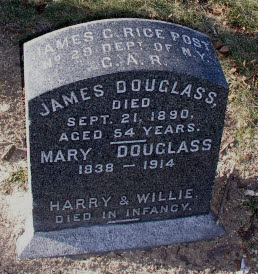
DOUGLASS (or DOUGLAS), JAMES (1836-1890). Corporal, 107th New York Infantry, Company F; private, 145th New York Infantry, Company K. Douglass enlisted as a private at New York City on August 11, 1862, and mustered into the 145th New York on September 11. He was transferred into the 107th Infantry on December 9, 1863, was promoted to corporal around June 15, 1864, and mustered out on June 5, 1865, at Washington, D.C. As per his obituary in the Mail and Express, he was a color bearer in the 107th, and fought at Chancellorsville, Virginia, and Gettysburg, Pennsylvania.
The New York City Directory of 1888 lists Douglass as a painter. The Veterans Schedule of 1890 confirms his military service. A member of James C. Rice Post #29 of the G.A.R., he was known to his comrades as “Faithful Jim.” His last address was 236 East 40th Street, New York City. He died after falling from a scaffold on the northeast corner of 38th Street and Madison Avenue in Manhattan. Mary Douglass, who is interred with him, applied for and was granted a widow’s pension in 1896, certificate 367,364. Section 17, lot 17245, grave 58.
DOUGLASS (or DOUGLAS), JOHN T. (1836-1896). Private, 67th New York Infantry, Companies K and B; captain, 65th New York Infantry, Company A. Of English birth, he enlisted as a private on September 4, 1861, and mustered into Company K of the 67th New York. His pension record indicates that he also served in Company B of that regiment but the date of that transfer is unknown. He was transferred with a promotion to first sergeant on June 4, 1864, and mustered into the 65th New York that day. During his service, he was wounded at Cedar Creek, Virginia, on October 19, 1864, promoted to first lieutenant on November 21, 1864, and to captain on May 31, 1865, but did not muster in that rank, and mustered out on July 17, 1865, at Hall’s Hill, Virginia.
After the Civil War ended, he re-enlisted as a first lieutenant on August 31, 1865, at Jackson, Mississippi, and was commissioned into the Field and Staff of the 108th United States Colored Infantry (USCT) as a first lieutenant and regimental quartermaster that same day. At some point, he was transferred to Company G before he mustered out on an unknown date. In 1882, his application for an invalid pension was approved, certificate 261,697. He may be a relative of George Douglass (see) who is buried in the same lot. As per his obituary in the Brooklyn Daily Eagle, he was a member of the Onward Commandery of the Golden Cross, a fraternal organization; his comrades from that association were invited to attend his funeral. He died at his home in Brooklyn. The cause of his death was heart disease. Section 14, lot 4969, grave 265.
DOWLING (or DOWNING), JOHN WILLIAM (1845-1914). Private, 12th Regiment, New York State National Guard, Company F. Born in Greenwich Village, Dowling, whose pension record includes the misspelling “Downing,” was a veteran who served with the 12th New York in 1862. On May 27, 1862, the regiment, commanded by Colonel William G. Ward (see), was ordered to Washington, D.C. It left New York June 6, and mustered into United States service for three months. The 12th served at Harpers Ferry, (now West Virginia), in the 4th Brigade, volunteered to stay over its term of service, and was surrendered with Harpers Ferry. It mustered out at New York City on October 8, 1862, and was declared exchanged on January 11, 1863.
A Democratic politician who served in the Ninth Ward, Dowling was also a restaurateur. The 1890 Veterans Schedule confirms his military service. His application for an invalid pension was granted in 1897, certificate 963,680. According to the census of 1910, he was employed as a lunchroom proprietor. He last lived at 2927 West 5th Street in Coney Island, Brooklyn. He died of a carcinoma. His death was announced in the New York Herald. An application for a minor’s pension was filed in 1914, application 1,035,133, but there is no certificate number. Section 16, lot 14888, grave 436.
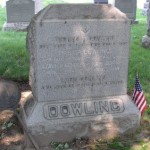
DOWLING, THOMAS ANDREW (1843-1931). Corporal, 24th Connecticut Infantry, Company H; drummer, 25th New York Infantry, Company B; Artillery Department, Military Academy, United States Army, 5th United States Artillery, Company K. On May 11, 1861, he enlisted at New York City, mustered into the 25th as a drummer on June 13, 1861, and mustered out on July 20, 1862, at Washington, D.C. He re-enlisted as a private on September 26, 1862, as a resident of Hamden, Connecticut, mustered into the 24th Connecticut on November 18, was promoted to corporal on March 1, 1863, and mustered out on September 30, 1863, at Middletown, Connecticut. According to pension records he also served in the Artillery Department of the Military Academy, United States Army, and the 5th United States Artillery. He applied for an invalid pension, application 1,357,398. He last lived on St. John’s Place in Brooklyn. His death was attributed to “cardia.” Proud of his service in the war, a G.A.R. shield adorns his stone at Green-Wood. Mary A. Dowling received a widow’s pension in 1932, certificate A-4-18-32. Section 131, lot 32164.
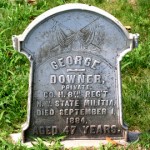
DOWNER, GEORGE (1837-1884). Private, 8th Regiment, New York State Militia, Company H. Downer enlisted on April 20, 1861, served for three months with the 8th Regiment and mustered out with his company on August 2.
As per the 1870 census, the 1872 and 1876-1878 New York City Directories, and the 1880 census, he was a carman/driver. The 1879 and 1884 New York City Directories list him as a driver. The 1882-1884 New York City Directory notes he was a cartman who lived at 38 Vandam Street, his last address. In 1891, Eleanor Downer, applied for and received a widow’s pension, certificate 339,658. Section 181, lot 10157.
DOWNES, JOHN HENRY (1838-1909). Second lieutenant, 88th United States Colored Infantry (USCT), Company H; sergeant, 21st New York Light Artillery. A law student at the time of his enrollment, Downes stood 6′ 1″ tall with gray eyes and a fair complexion. He enlisted as a sergeant at Oswego, New York, his birthplace, on August 30, 1862, mustered into the 21st Light Artillery on December 12, was reduced to ranks on July 1, 1863, and was discharged for promotion on August 29, 1863. His obituary and pension records indicate service as a second lieutenant in the 88th USCT which was organized from the 17th Infantry, Corps d’Afrique. He was discharged on April 18, 1864, at Oswego, while on sick leave.
A dentist, he lived in Titusville, Pennsylvania, after the war and came to New York City in 1879, where he set up a practice for 30 years at 14 Barclay Street in Manhattan. The 1885-1886 and 1894-1895 Brooklyn Directories list him as a dentist at that address. Downes belonged to a Masonic lodge. In 1907, he applied for and received a pension, certificate 1,143,393. As per his obituary in the New York Herald, members of his Masonic lodge were invited to his attend his funeral. The master of his lodge and the potentate of the Mecca Temple, of which he also was a member, requested that fellow brothers attend Downes’s funeral. He died after a fall at his home at 153 Herkimer Street in Brooklyn. His minor children received a pension in 1909, certificate 694,501. Section 169, lot 14310.
DOWNEY, PHILIP J. (1822-1877). Captain, 82nd New York Infantry, Company I; 59th New York Infantry, Company F; first lieutenant, 3rd Independent Battery, New York Light Artillery. A New York City native, Downey ran a boarding house as per the census of 1860. At the onset of the Civil War, he enlisted at New York City on May 21, 1861, mustered into the 3rd Independent Battery of the New York Light Artillery as a first lieutenant on June 17, and transferred into the 82nd Infantry on July 1. As per his muster roll, he was not commissioned as a first lieutenant during his service in the New York Light Artillery. He was formally commissioned as a first lieutenant on January 23, 1862, with rank from his date of enlistment on May 21, 1861. He was wounded on May 31, 1862, at Fair Oaks, Virginia, was promoted to captain on August 30, 1862, with rank from June 29 of that year, and was wounded on May 6, 1864, at the Wilderness, Virginia. On July 10, 1864, he was transferred into the 59th New York from which he was discharged for disability resulting from wounds on October 22, 1864. In 1864, his application for an invalid pension was granted, certificate 39,291. As per the 1865 New York State census, Downey was identified as being in the United States Army and living at 82 York Street.
Downey was listed in the New York City Directory of 1866 as head of a boarding house. The 1867-1870 Brooklyn Directory lists him as a letter carrier living at 92 York Street. The 1870 census and the 1873-1876 and 1877 Brooklyn Directories indicate that he was a retail liquor dealer. As per his obituary in the Brooklyn Daily Eagle, he was a member of the Odd Fellows, a fraternal organization, and the Mexican War Veterans. Members of both organizations were invited to his funeral. His death was also announced in the New York Clipper. Downey last lived at 445 1st Street in Brooklyn. His widow, Mary Downey, received a pension upon his death in 1877, certificate 179,463. Mary Livingston, guardian, applied for a minor’s pension that was granted in 1886, certificate 231,454. Section 85, lot 3667, grave 224.

DOWNING, FREDERICK (1833-1881). Private, 13th Regiment, New York State National Guard, Company B. Originally from England, he was employed as a clerk as per the census of 1850. Downing enlisted as a private in 1862 for a tour of three months and served in Company B of the 13th Regiment’s Heavy Artillery. According to the New York City Directory for 1872, he was a clerk who lived at 143 Lawrence Street in Brooklyn. He died at the Occidental Hotel in New York City from dipsomania, an uncontrollable urge for alcohol. Section 3, lot 8370.
DOWNING, GEORGE W. (1843-1876). Private, 11th New York Cavalry, Company K. Originally from England, Downing enlisted as a private on August 29, 1862, at Washington D.C., and mustered into his company on that day. He mustered out of service at Memphis, Tennessee, on June 12, 1865. His last residence was 269 Hewes Street in Brooklyn. The cause of his death was pneumonia. Section 64, lot 4071, grave 90.

DOWNING, JOHN A. (1829-1894). Private, 83rd New York Infantry, Company G. Downing was a native of New York, although his Draft Registration says New Jersey, and was a carpenter as per the census of 1850. After he enlisted at New York City as a private on September 13, 1861, he mustered into the 83rd the next day, and was discharged for disability on September 25, 1862, at Fort McHenry in Baltimore, Maryland.
According to the census of 1880, he was living in East Orange, New Jersey, working as a carpenter, and suffering from kidney disease. The Orange (New Jersey) Directory for 1883 lists him as a carpenter. The Veterans Census of 1890 confirms his military service. In 1890, his application for an invalid pension was approved under certificate 925,873. He last lived in East Orange, New Jersey. He died from cirrhosis of the liver. Maria Downing, who is interred with him, applied for and received a widow’s pension in 1894, certificate 438,555. Section 135, lot 27263, grave 2417.
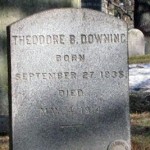
DOWNING, THEODORE B. (1835-1914). Private, 13th Regiment, New York State Militia, Company G. A New York City native, Downing enlisted there in 1861 as a private. He mustered into the 13th Regiment for its three month activation and mustered out with his company at the expiration of his enlistment.
As per the 1863 Brookyn Directory, Downing was a jeweler whose office was at 19 Maiden Lane in New York City and who was living at 82 Montague Street in Brooklyn. According to the Brooklyn Directory for 1888-1890, he was living at 150 Pierrepont Street in Brooklyn. Downing was listed in the 1890 Veterans Schedule as a U.S. soldier. His last residence was 20 Clinton Street, Brooklyn. His death was caused by lobar pneumonia. Section 66, lot 419.
DOYLE, NICHOLAS (1841-1866). Private, 37th New York Infantry, Company E. On May 5, 1861, Doyle, a New Yorker by birth, enlisted as a private at New York City and mustered into Company E of the 37th New York on June 6. He was taken prisoner at Second Bull Run, Virginia, on August 29, 1862, and was paroled and returned to his regiment on May 15, 1863. He mustered out on June 22, 1863, at New York City. His last residence was 400 Fourth Avenue, Manhattan. He died from a condition called anasarca, widespread swelling of the skin. Section 181, lot 10298.
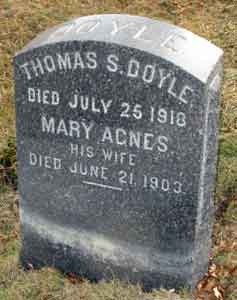
DOYLE, THOMAS S. (1844-1918). Private, 56th Regiment, New York State National Guard, Company C. A Brooklyn native, Doyle enlisted there as a private on July 11, 1864, served with the 56th Regiment for its 100 day activation, and mustered out on November 6. He was discharged at the completion of his term. As per the census of 1880, he was employed as a city weigher; the census of 1900 notes that he was a clerk in a sugar refinery. The Veterans Schedule of 1890 confirms his Civil War service. He applied for and received an invalid pension in 1894, certificate 1,128,468.
In 1910, Doyle was named in a scandal involving supervisors at the Customs House who conspired to defraud the United States government of full duty by short-weighing of sugar on the docks. Doyle, an employee at the Arbuckle Sugar Refinery, was mentioned the Brooklyn Daily Eagle on April 23, 1910, as being under indictment for giving bribes of $50 on two occasions, once in May and once in June of 1907. Another article in The New York Times noted that Arbuckle evaded about $600,000 in duties and that payments of from $50 to $100 were made on the 1st and 15th of each month to government weighers. This is validated in an article in the New York Call on September 16, 1910, which stated that Arbuckle Sugar agreed to pay the government $695,000 for its part in the fraud. That same article goes on to say that Thomas Doyle testified at the trial of others involved in the fraud case that, as assistant dock superintendent of the Arbuckle plant, he personally gave money to the supervisors in charge of weighing and to the assistant weighers. Doyle went on to testify that he made lists of the people to whom payments were to be made, submitted the list to the dock superintendent for endorsement, mailed the list to the Arbuckles, then received envelopes with the names of each recipient.
According to his obituary in the Brooklyn Daily Eagle, Doyle was a member of the Grand Army of the Republic, a volunteer fireman with Crystal Hose #4, and had a daughter who was a nun with the Order of St. Joseph. His last residence was 57 Dean Street in Brooklyn. His death was attributed to nephritis. A requiem Mass was celebrated in his memory at the Church of the Nativity at Madison Street and Classon Avenue. In addition to his daughter, he was also survived by a son. Section 128, lot 31262, grave 195.
DOYLE, WILLIAM H. (1842-1897). Private, 11th New York Infantry, Company A. After Doyle enlisted at New York City as a private on April 20, 1861, he mustered into the 11th New York, also known as the 1st Fire Zouaves, on May 7, and was discharged on June 2, 1862, at New York City. On April 18, 1883, he became a member of the G.A.R., James H. Perry Post #89. His application for an invalid pension was approved in 1896, certificate 889,909. As per his obituary in the Brooklyn Daily Eagle, members of the Perry Post were invited to his funeral. He last resided at 345 Pulaski Street in Brooklyn. Nephritis was the cause of his death. Mary Doyle was awarded a widow’s pension, certificate 457,265. Section 185, lot 18186, grave 3.
DRAKE, NELSON S. (1831-1880). Captain by brevet, United States Volunteers Medical Staff; assistant surgeon, 16th New York Cavalry. A native of Paterson, New Jersey, Drake is listed as a graduate of Columbia University’s College of Physicians and Surgeons, class of 1853; that database confirms his Civil War service. He was listed as a physician in the 1857-1862 Brooklyn Directory; at that time, he lived at 127 Clinton Avenue.
During the Civil War, he was the medical officer on the United States Sanitary Commission’s hospital ship Daniel Webster as per an article in The New York Times on July 18, 1862. According to a series of medical documents offered for auction in 2019, Drake, in November 1862, was a contract physician, a private physician agreed to “perform the duties of a Medical Officer” and “furnish and keep in good order complete sets of amputating, trephining (drilling or scraping holes in the skull), and pocket instruments” for at least three months. Drake made the aforementioned agreement with Army Surgeon and Medical Director Charles McDougall.
Drake enlisted as an assistant surgeon at Albany, New York, on August 19, 1863, and was commissioned into the Field and Staff of the 16th New York Cavalry the next day. He was dismissed on May 11, 1864, at Washington, D.C., by court-martial for “conduct unbecoming an officer & gentleman.” On May 18, 1864, he was commissioned into the United States Volunteers Medical Staff as an assistant surgeon. His dismissal was removed on June 24, 1864. He tendered his resignation on September 21, 1865, citing his wish to return to “civil life” as a physician in Brooklyn “for the sake of [his] wife and child.” Drake was promoted to captain by brevet on October 7, 1865.
The 1870-1873 and 1873-1876 Brooklyn Directories identify Drake as a physician. According to the censuses of 1870 and 1880, Drake was a physician with a personal estate of $1,000, living in his mother-in-law’s home in Brooklyn. The Brooklyn Directory of 1880 confirms that he was a physician with an office at 191 Clinton Street. His last residence was 208 Union Street in Brooklyn. He died from “oedema of lung.”
In 1904, Luella Drake, who is interred with him, applied for and was granted a widow’s pension, certificate 654,956. His pension index card contains the notation “Old Wars”; this is a reference to service in volunteer units between the American Revolution and the Civil War. An article in the Brooklyn Daily Eagle on June 13, 1907, about the 40th anniversary of the Mistletoe Lodge of Freemasons lists Nelson Drake as a well-known former member and master. Section 109, lot 7375.

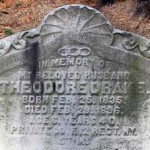
DRAKE, THEODORE (1825-1896). Private, 12th Regiment, New York State Militia, Company F. Drake, who was born in New York State on February 25, 1825, enlisted as a private in 1861 and served in the 12th Regiment when it was activated that year for three months. As per the notation on the photo below of Drake in uniform, obtained from a descendant, he may have been an honor guard for the body of President Abraham Lincoln in New York City. He joined the G.A.R. on October 3, 1883. His last residence was 215 9th Avenue in Long Island City, New York. Drake died of cerebral apoplexy. Section 44, lot 5060, grave 2.

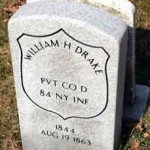
DRAKE, WILLIAM H. (1844-1863). Private, 84th New York (14th Brooklyn) Infantry, Company D. A resident of the Gowanus section of Brooklyn and New Yorker by birth, he enlisted at Brooklyn on August 18, 1862, and mustered into the 14th Brooklyn the next day. As per his muster roll, he was a laborer who was 5′ 10½” tall with brown hair and blue eyes. He was badly injured at the Battle of Antietam, Maryland, on September 17, 1862. He died of consumption on January 9, 1863, at Washington, D.C. On April 13, 1863, Susan Drake, his mother, filed for and received a pension, certificate 78,934. Section 115, lot 13536 (Soldiers’ Lot), grave 54.
DRAPER, GILBERT A. (1835-1863). Lieutenant colonel, 159th New York Infantry; captain, 65th New York Infantry, Companies F and A. As per the census of 1850, Draper was born in New York and employed as a clerk. The 1857-1862 and 1863 Brooklyn Directories list him as a bookkeeper living at 77 Lafayette Avenue. After his enlistment at New York City as a first lieutenant on June 17, 1861, he was commissioned into the 65th New York Infantry, Company F, on July 25. He was discharged for promotion to captain on July 17, 1862, effective upon an intra-regimental transfer to Company A. On August 28, 1862, he was promoted to major and commissioned into the 159th New York’s Field and Staff, and was promoted to lieutenant colonel on November 25, 1862.
Draper was killed at Irish Bend, Louisiana, on April 14, 1863. Colonel Henry Birge, his commanding officer, praised him in his field report of April 22, citing the casualties there, “…. It records the name of Lieutenant-Colonel Gilbert A. Draper, who fell with three wounds, either of which would have been fatal. A good soldier, a gallant officer, an estimable gentleman, his death is mourned by his friends and is a loss to his country…” The cause of death was officially recorded as vulnus sclopet, or multiple gunshot wounds.
As per his obituary in the New York Herald on December 19, 1863, his remains were escorted to Green-Wood Cemetery by a battalion from the 23rd National Guard, Companies A, B, C, D, I and G, preceded by a band that played funeral dirges. His obituary noted that Lieutenant William Plunkett (see) was killed in the same battle and interred at Green-Wood earlier that same day. On June 1, 1863, Louisa Draper, who is interred with him, applied for and received a widow’s pension, certificate 13,156. Originally interred at Green-Wood on December 18, 1863, the cemetery database shows that he was re-interred at this location on November 26, 1873. Section 185, lot 20876.
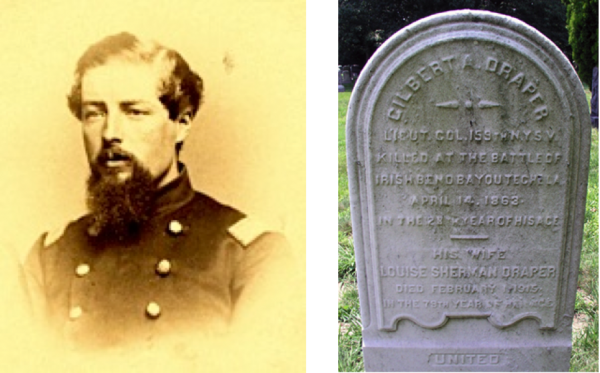
DRAPER, HENRY (1837-1882). Surgeon, 12th Regiment, New York State National Guard. Draper, who was born in Virginia, was the son of scientist and pioneer photographer John Draper. He received his M.D. in 1858 from the University of the City of New York, but quit medicine in 1860 to teach natural science at that school. Returning to medicine during the Civil War, he enlisted at New York City on May 31, 1862, and was commissioned into the 12th New York State National Guard as a surgeon on that date. He mustered out on October 8, 1862, at New York City.
After the war, Draper taught physiology and analytical chemistry and served as dean at his alma mater. A celestial photographer, he was best known for pictures he took of the moon through a reflecting telescope that he built at Hastings-on-Hudson, New York. He was also the first to photograph the spectrum of a star, capturing Vega on film in 1872, and was the first to photograph a nebula. In 1877, he announced his discovery of oxygen on the sun, described in one contemporary account as “perhaps the most original discovery ever made in the physical science by an American.” According to cemetery records, he also held a law degree. He last lived in Manhattan. Section 93, lot 24.
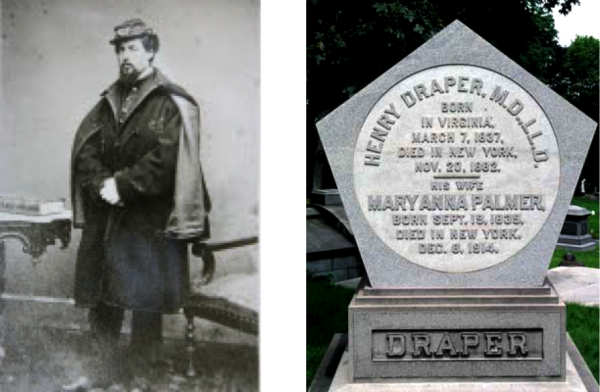
DRAPER, JOHN WILLIAM (1811-1882). Scientist and pioneer photographer. Born near Liverpool, England, he studied with private tutors, in public schools, and at the University of London. In 1832 he came to the United States and graduated with a degree from the medical department of the University of Pennsylvania in 1836. He authored several scientific papers which developed his reputation, and began teaching chemistry and natural philosophy at Hampden-Sidney College in Virginia. He was named professor of chemistry at the University of the City of New York in 1838 and held that position until his death, also becoming its president in 1850. He was a pioneer, along with his partner Samuel F.B. Morse (see), in photography in this country. He may have taken the first close-up photograph of the human face when he “gently” put his sister Dorothy’s head in a vice to hold it steady for a long exposure in the fall of 1839, and he took the first photograph of the moon in 1840. Draper created a bromide coating which improved the sensitivity of photographic plates, developed uses of spectrum analysis, and took the first successful photograph through a microscope. He was also founder and president of the New York University Medical School and the American Chemical Society.
Draper also has a Civil War connection. He was the author of a three-volume history of the Civil War and History of the Conflict Between Religion and Science, which was internationally popular, though it was banned by the Catholic Church. Draper also wrote History of the Intellectual Development of Europe, in which he championed faith in science over the supernatural. He is best known to science for his research on radiant energy, but he also conducted pioneering experiments in osmosis, photosynthesis, and the telegraph (working with Samuel F.B. Morse, he was the first to establish that electricity could be used to send messages over long distances). Section 73, lot 968.

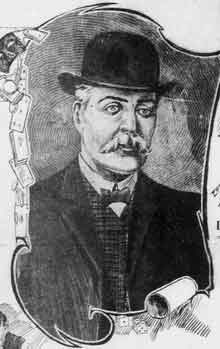
DRAPER, THOMAS H. (1839-1913). First lieutenant, 47th New York Infantry, Company B. Of Irish birth, his family immigrated to the United States in 1848 on the West Point, a passenger ship. His father, John Draper, was a well-respected cotton-merchant in New York City. During the Civil War, Thomas Draper enlisted at Brooklyn as a sergeant on July 9, 1861, rose through the ranks to second lieutenant and first lieutenant, and was discharged on June 27, 1862.
It appears that he may have been the notorious Shang Draper, who, despite a long list of arrests and aliases, was never convicted of any crime. A saloon-keeper in the 1870s, Shang would drug unsuspecting patrons before taking their valuables giving him his infamous nickname, a corruption of Shanghai. He also operated a panel house, a “house of ill repute,” whose rooms had sliding door panels that hid the unsuspecting patron’s clothes and wallet, making it possible to steal valuables from the otherwise-engaged patron. In his later years, Draper was a horse owner and backer of racetracks and poolrooms.
As per his obituary in The New York Times, he was “aided” by the police, made money wherever he went, and left a fortune. The obituary went on to say that he was a member of the Doric Lodge of the Masonic Order, and was buried with Masonic rites. (An investigation of the Freemasons based upon his connection to the order yielded no wrongdoing. An article in the Brooklyn Daily Eagle on May 5, 1904, describing that investigation included the testimony of Robert Pinkerton who described Draper as a family man who cared for his paralyzed brother and who had become a victim of his “childhood” nickname.) He last resided at 234 Central Park West in Manhattan. Draper died of nephritis. Section 121, lot 18056, grave 4.
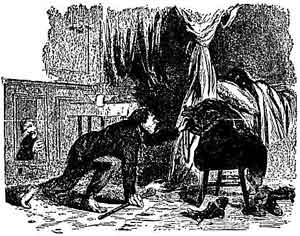
DREAGER (or DREGER, DREGGER), HENRY G. (1846-1899). Private, 9th New York Cavalry, Company C. Dreager was born in Prussia and immigrated to Jamestown, New York, as a young boy. As per his obituary in the New York Tribune, he was living there at the onset of the Civil War and was one of the first to enlist in the 9th New York Cavalry when the unit was raised in that area in 1862. However, soldier records indicate that he enlisted on February 5, 1864, at Ellicott, New York, as a private, and mustered into the 9th New York Cavalry that same day. His muster roll notes that he was a baker by trade who was 5′ 6″ tall with hazel eyes, dark hair and a dark complexion. He received a town bounty of $300 upon his enlistment. Dreager mustered out on July 17, 1865, at Cloud’s Mills, Virginia. His obituary in the New York Daily Tribune notes that he was slightly wounded during his service.
On October 20, 1870, Dreager became a naturalized citizen. As per the 1880 census, he was a varnisher. The 1880-1882 and 1884-1886 Brooklyn Directories list him as a contractor; in the 1890-1892 Brooklyn Directory, Dreager is identified as a polisher. He was a member of George C. Strong (see) Post #534 of the G.A.R. in Brooklyn as of April 20, 1886. In 1898, he applied for an invalid pension, certificate 973,119.
As per his obituaries in the Brooklyn Daily Eagle and the New York Daily Tribune, members of Strong Post and members of Clarence Mackenzie (see) Post #399 of the G.A.R., to which he also belonged, were invited to attend his funeral. In addition, he was active in Republican Party politics and belonged to the Veterans’ Association of the 9th Cavalry, the Independent Order of Odd Fellows and the Knights of Honor, a fraternal organization that helped its members with health and funeral costs.
At the time of his death, he resided at 466 Van Buren Street in Brooklyn. Bettie Dreager, who is interred with him, received a widow’s pension, certificate 498,036. After Bettie Dreager’s death, an article in the Brooklyn Daily Eagle on January 14, 1904, noted her enormous girth and implied that her funeral was delayed until a large-size casket could be obtained. These comments were denied by her family. Section 135, lot 30010, grave 370.
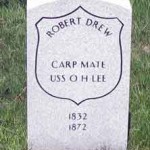
DREW, ROBERT (1832-1872). Carpenter’s mate, United States Navy. Originally from Ireland, Drew enlisted in the United States Navy and served on board the USS O.H. Lee as a carpenter’s mate. The dates of his service are not known. His last residence was 902 Carney Street, New York City. His death was caused by sunstroke. Section 126, lot 2458, grave 1082.
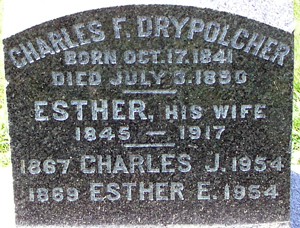
DREYPOLCHER (or DRYPOLCHER, DREYPOELCHER), CHARLES F. (1841-1890). Private, 71st Regiment, New York State National Guard, Company D. Dreypolcher, a native New Yorker of Russian descent, enlisted on October 6, 1862. His regiment was called into service during the Gettysburg campaign in Pennsylvania and was subsequently assigned to guard the Long Bridge in northern Manhattan during the Draft Riots of July 1863. According to his descendants, after falling ill or sustaining an injury, he was declared unfit for duty and discharged on December 1, 1864.
He is likely the Charles Dreypolcher who is listed as a cabinetmaker living at 460 West 33rd Street in the 1882-1883 New York City Directory. He also worked as an upholsterer. He last lived at 300 West 129th Street in Manhattan. Section 206, lot 21347, grave 511.
DRINKER, JOHN D. (1830-1867). Corporal, 4th New York Infantry, Company B; private, 16th New York Heavy Artillery, Company G. A New Yorker by birth, he was a druggist living in Honesdale, Pennsylvania, as per the census of 1850. Drinker enlisted as a private at New York City on April 22, 1861, and mustered into Company B of the 4th New York on May 25. According to his muster roll, he was a druggist who was 5′ 9½” tall with blue eyes, dark hair and a florid complexion. On August 5, 1861, he was promoted to corporal of his company but was reduced in rank to private on October 19. He mustered out on May 25, 1863, at New York City. On December 31, 1863, he re-enlisted at New York City as a private, mustered into the 16th New York Heavy Artillery on January 9, 1864, and mustered out on August 21, 1865, at Washington, D.C. His last address was 209 Fort Greene Place, Brooklyn. Drinker succumbed to angina pectoris. Section 152, lot 18173.
DRUMM, THOMAS (1824-1896). Chaplain, 9th New Jersey Infantry; 102nd New York Infantry; United States Volunteers Hospital Chaplains. Originally from Dublin, Ireland, he was a graduate of Trinity College there and earned a degree in medicine. He practiced medicine in Barbados, West Indies, for five years beginning in 1849 before coming to New York to study theology at the General Theological Society. In 1856, he was admitted to the Protestant Episcopal priesthood and headed parishes in Carbondale, Pennsylvania, and Trenton, New Jersey, before serving as chaplain at the Home for Incurables in Fordham, New York.
Drumm enlisted as a chaplain on October 3, 1861, was commissioned into the Field and Staff of the 9th New Jersey five days later, and resigned on October 15, 1862. He re-enlisted as a chaplain on February 13, 1863, at Aquia Creek, Virginia, was immediately commissioned into the Field and Staff of the 102nd New York, and was discharged on August 6, 1863. After he was commissioned into the U.S. Volunteers Hospital Chaplains on July 30, 1864, he mustered out on October 7, 1865. In 1876, his application for an invalid pension was granted, certificate 142,943. At the time of his death, he was the chaplain for the Port of New York, a position he held from 1887. He last lived at 939 8th Avenue in Manhattan. He died from heart disease. Sarah LeBaron Drumm applied for a widow’s pension, application 644,000, but no certification number is available. Section 36, lot 864, grave 15.
DRUMMOND, MORRIS T. (or D.) (1842-1884). Private, 84th New York (14th Brooklyn) Infantry, Company B. A native of New York City, Drummond enlisted at Brooklyn as a private on May 18, 1861, mustered into the 14th Brooklyn five days later, and was discharged for disability on August 4, 1861, at Arlington, Virginia. His last residence was at 188 Duffield Street in Brooklyn. His death was caused by gastroenteritis. Section F, lot 19546.
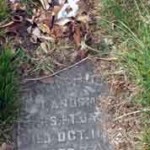
DUBLE, JOHN (1820-1897). Landsman, United States Navy. Duble was born in Fredericksburg, South Carolina, and was a waiter at the time of his enlistment. As per his application for an invalid pension from the United States Navy in 1886, he enlisted as a landsman at New York City on August 23, 1863, served aboard the USS Fort Jackson, and was discharged on August 18, 1864, at Portsmouth, Virginia. At the time of his pension application, he described himself as 5′ ¼” tall with a yellow hair and black eyes. An illiterate, he signed his application with his mark. He claimed disability from disease of his right foot, injury of his right leg, rheumatism, and respiratory disease. Duble noted that he was injured in the right leg from his knee to his foot at Beaufort, South Carolina, in 1863, and recalled “striking my said leg against a Guncarriage, and then falling…” He was treated by the ship’s doctor at Beaufort. Duble’s pension of $12 per month as of July 1, 1890, was granted under certificate 7,975. His service as a landsman in the Navy is confirmed by the Veterans Schedule of 1890.
The 1896-1898 Brooklyn Directory lists Duble as a laborer living at 170 21st Street in Brooklyn, his last address. He died from nephritis. Notice of his death was posted in the Brooklyn Standard Union. His Civil War service is confirmed by an inscription on his tombstone. Section 3, lot 18372.
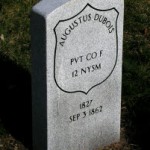
DUBOIS, AUGUSTUS (1827-1862). Private, 12th Regiment, New York State Militia, Company F. Born in Germany, he immigrated to the United States in 1849. Dubois served in the 12th New York State Militia for three months in 1861. He died from consumption in New York City. Section 115, lot 13536 (Soldiers’ Lot), grave 49.
DUBUAR, CHARLES A. (1816-1880). Private, 5th New York Heavy Artillery, Company B. Dubuar was born in New York. After enlisting on March 28, 1862, at Brooklyn, as a private, he mustered the next day into the 5th New York Heavy Artillery. Dubuar was discharged for disability on October 28, 1862, at Fort Marshall in Baltimore, Maryland.
The 1868 Brooklyn Directory lists him as a clerk living at 116 Ainslee Street. According to the 1870 census, he was employed as a hardware clerk, owned real estate valued at $3,000, and had personal effects worth $1,500. As per the 1873-1876 Brooklyn Directory, he was a clerk living at 191 Ainslie Street. The 1880 census lists him as a “gentleman.” He last resided at 191 Ainslie Street in Brooklyn. Section 175, lot 17812.
DUELL, JAMES (1832-1877). Private, 9th New York Infantry, Company A. Originally from Montreal, Canada, and a brushmaker according to the 1862 Brooklyn Directory, Duell enlisted at New York City as a private on August 20, 1862, and mustered into the 9th New York on that date. At that time, he lived at 505 Columbia Street in Brooklyn. He was 5′ 9″ tall with brown eyes, dark hair and a dark complexion. On September 17, 1862, he was taken as a prisoner of war at the Battle of Antietam, Maryland. The dates of his exchange, parole, and discharge are unknown. As per his muster roll, he deserted after his parole and was last seen in New York City in 1863.
The 1870 census lists him as a brushmaker living in Caldwell, New Jersey. As per the 1875-1876 New York City Directory, he was a brushmaker living at 31 Catharine Street. His last residence was at 44 Pike Street in New York City. Duell died of phthisis. Section 186, lot 18893.
DUFF, ALFRED (1839-1909). Private, 22nd Regiment, New York State National Guard, Company C. A native of New York State, Duff enlisted at New York City on May 28, 1862, mustered immediately into the 22nd Regiment, and was discharged at New York City after serving three months on September 5. In 1907, he applied for and received a pension, certificate 1,138,205. He may be the younger brother of Edwin Duff (see). As per his obituary in the New York Herald, his funeral took place at the Brick Presbyterian Church in East Orange, New Jersey, upon arrival of the train from New York; the obituary noted that he died suddenly. His last residence was 434 Williams Street in East Orange, New Jersey. Duff’s death was attributed to heart trouble and pulmonary edema. Section 162, lot 15604, grave 8.
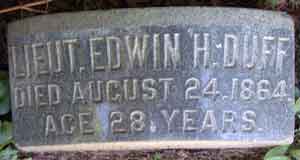
DUFF, EDWIN H. (1835-1864). Second lieutenant, 51st New York Infantry, Companies B and I; sergeant, United States Army Signal Corps. A native of New York, he enlisted there as a private on September 7, 1861, and mustered into Company B of the 51st New York two days later. Effective upon his promotion to second lieutenant on March 28, 1862, he joined Company I, and was discharged on August 1 of that year. According to his pension record, he also served as a sergeant in the United States Signal Corps. He died of typhoid fever in Washington, D.C., on August 25, 1864. He may be the older brother of Alfred Duff (see). His mother, Mary Duff, applied for a pension in 1865, and was granted one, certificate 68,714. Section 162, lot 15604.
DUFF, JAMES (1837-1870). Private, 42nd New York Infantry, Company K. Of Irish origin, Duff enlisted on June 22, 1861, at Long Island, New York, as a private. Six days later, he mustered into Company K of the 42nd. The date and place of his discharge are unknown. His last residence was 174 18th Street in Brooklyn. His death was caused by pneumonia. Section 147, lot 22456.
DUFF, MATTHEW (1842-1907). Sergeant, 83rd New York Infantry, Company A. Born in New York City, Duff enlisted there as a private and immediately mustered into the 83rd New York on May 27, 1861. During his service, he was detailed to the Ambulance Corps. He was promoted to corporal on an unspecified date and to sergeant on October 1, 1863. He mustered out on June 24, 1864, at New York City.
As per the census of 1870, he was an office clerk. In 1876, he applied for and received an invalid pension, certificate 1,047,113. According to the census of 1900, he was an insurance clerk; the 1904 Brooklyn Directory lists him as a merchant. Duff last lived at 263 Prospect Place in Brooklyn. Nephritis was the cause of his death. His obituaries in the New York Herald and the Brooklyn Daily Eagle, which cite his last address, report that his funeral took place at the chapel of the Home of Incurables at 183rd Street and 3rd Avenue in the Bronx. Sorchie A. Duff, who is interred with him, applied for and received a widow’s pension in 1907, certificate 643,086. Section 16, lot 9900, grave 4.
DuFLON, JR., JOHN FRANCIS LEWIS (1843-1880). Private, 8th Regiment, New York State National Guard, Company K. Duflon, who was born in New York State, descended from a Swiss family that came to Brooklyn long before his birth. Circa 1820, his grandparents, Jean François Louis and Madame DuFlon, who are also interred at Green-Wood, became proprietors of the Military Garden, located in downtown Brooklyn behind the current Brooklyn Municipal Building. A resort popular with society’s elite, the Military Garden was the scene of many balls and parties including one that hosted Marquis de Lafayette in 1824 and another that greeted President Andrew Jackson in 1833. The DuFlons sold the property in the 1840s and it became the Brooklyn Garden- – and a “honky tonk” – – by the 1860s. John Duflon worked in a hardware store as per the 1860 census. During the Civil War, Duflon enlisted as a private at New York City on May 29, 1862, mustered immediately into the 8th Regiment, and mustered out with his company after three months on September 10, 1862.
The census of 1870 lists him as a bookkeeper. The 1875-1876 New York City Directory and the 1880 census note that he was living in Manhattan and was employed as a fireman; the directory records his home address as 142 East Broadway. (In 1825, his grandfather, organized and was foreman of Brooklyn’s Lafayette Engine No. 5. His father, John F. L. DuFlon, was chief engineer of the Brooklyn Fire Department.) As per his obituary in the New York Herald, he was a member of Dahlgren Post#113 of the G.A.R.; members of his post were asked to assemble in uniform to attend his funeral. His last residence was 11 144th Street in the Bronx. Duflon’s death was due to phthisis. Section 15, lot 17263, grave 315.
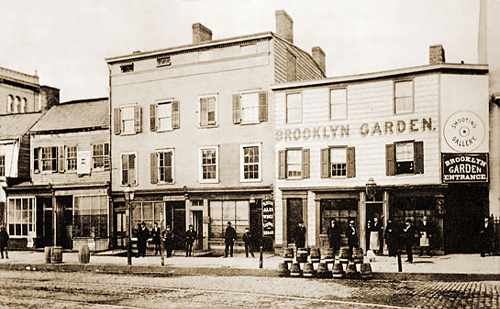

DuFRAINE, HENRY (1840-1868). Captain, 6th New York Infantry, Company E. A native of New York, DuFraine enlisted as a captain at New York City on April 25, 1861, was commissioned into the 6th New York five days later, and resigned on January 28, 1862. He last lived on Green Avenue in New York City. He succumbed to consumption. Section 85, lot 3330, grave 148.

DUGAN (or DUGGAN), JAMES (1841-1891). Private, 158th New York Infantry, Company K. Dugan enlisted on August 11, 1862, mustered into the 158th that day, and deserted at Brooklyn a month later on September 18. He last lived in New York City. Phthisis caused his death. Section 115, lot 4196, grave 102.
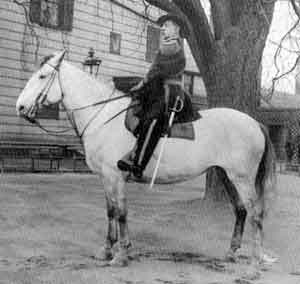
DUGAN, WILLIAM B. (1844-1926). Sergeant, 11th New York Cavalry, Company H. Born in Brooklyn, he enlisted there as a corporal on January 6, 1862, and mustered immediately into the 11th New York Cavalry. A mechanic by trade, he was 5′ 9″ tall with hazel eyes, brown hair and a light complexion. He was promoted to sergeant on August 27, 1862. According to military records, he deserted on February 22, 1863, at Washington, D.C., and rejoined his unit on March 15; his pay was docked for those 21 days. The records also show that he was mistakenly listed as deserting in October 1863 when, in fact, he lost his horse on October 20 and hadn’t actually deserted. On March 1, 1864, he was reduced in rank to private. Dugan was absent and sick in August and September 1864 at Hermitage Plantation and New Orleans, Louisiana. He mustered out on January 9, 1865, at Baton Rouge, Louisiana.
As per the Brooklyn Directories for 1873-1876 and 1888, he worked as a carpenter/woodmolder; the census of 1900 lists him as living in Queens and working as a policeman. In 1905, his application for an invalid pension was granted, certificate 1,129,505. He was a member of the G.A.R. His last address was 9706 117th Street in Richmond Hills, Queens. Dugan’s death was due to a cerebral hemorrhage. As per his obituary in the Brooklyn Daily Eagle, he was survived by his wife, two sons and two daughters. In 1926, Josephine Dugan, who is interred with him, applied for and received a widow’s pension, certificate A-5-14-37. Section 82, lot 2278.
DUKE, HENRY CLAY (1841-1895). First sergeant, 39th New York Infantry, Company F; private, 36th New York Infantry, Company C. A native New Yorker, he enlisted at New York City as a private on May 15, 1861. A printer by trade, he was 5′ 4½” tall with gray eyes, dark hair and a dark complexion. On June 17, 1861, he mustered into the 36th New York Infantry, Company C, served two years and mustered out on July 15, 1863, at New York City. On December 4, 1863, he re-enlisted at New York City as a private, and mustered immediately into the 39th New York. He was promoted to first sergeant on December 14, and served until he mustered out at Alexandria, Virginia, on July 1, 1865.
The 1877 New York City Directory lists Clay as a printer living at 334 East 11th Street in Manhattan. As per the 1880 census, Duke was employed as a printer. His last residence was 189 East 108th Street, New York City. He died from nephritis. In 1896, Charlotte Duke, his eldest daughter and guardian of his youngsters, applied for and was granted a pension for his minor children under certificate 437,949. Section 135, lot 27263, grave 2085.
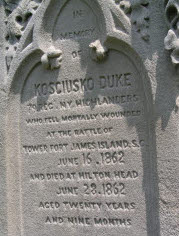
DUKE, KOSCUISKO (1841-1862). Corporal, 79th New York Infantry, Company D. A native New Yorker, he was employed as a carpenter in 1860. The 1860 census indicates that his Scottish-born father, with whom he lived, was also a carpenter who owned real estate valued at $20,000, and had person effects of $500. At the onset of the Civil War, Duke enlisted at New York City on May 13, 1861, and mustered into the 79th New York, also known as the Highlanders or Scottish Guard. Wounded in battle on June 16, 1862, at James Island, South Carolina, he succumbed to his injuries on June 28, 1862, at Hilton Head, South Carolina. (Note: The Register of Deaths for United States Volunteers states that he died on June 24 of vulnus sclopet or gunshot wounds.) He was listed as a corporal at the time of his death; the date of his promotion is unknown. Brigadier General Henry Benham, who was temporarily in charge of the brigade and who had ordered the foolhardy attack in which Duke died, was later relieved of his command, arrested for disobedience of orders, and had his appointment revoked.
Duke lived with his parents at 149 West 42nd Street in New York City. As per his obituary in The New York Times on July 17, 1862, he was a “dutiful son, true comrade and brave soldier.” First interred at Green-Wood on July 17, 1862, in lot 9895, grave 300, his remains were moved on May 10, 1872, to their present location. In 1890, Margaret Duke, his mother, received a pension, certificate 305,014. Section 7, lot 14531.
DUKEMAN (or DUHEMAN), GEORGE (1840-1913). Corporal, 139th New York Infantry, Company C. A New York State native, Dukeman enlisted at Brooklyn as a corporal on August 21, 1862, mustered into the 139th New York on September 9, and was wounded in action at the Battle of Cold Harbor, Virginia, on June 2, 1864, resulting in a hospitalization of about five months. He was discharged from military service on May 12, 1865, at New York City.
According to the 1870 census, he was a post office clerk. In 1873, his application for an invalid pension was granted, certificate 126,978. His obituary in the New York Herald confirmed his service in the Civil War and noted that he had been a clerk in the New York Post Office for 50 years. He last lived at 841 Hancock Street in Brooklyn. Shortly after his death from myocarditis in 1913, Christiana Dukeman applied for and received a widow’s pension under certificate 781,332. Section 131, lot 33962, grave 2.
DUMMER, SAMUEL RUSSELL (1825-1912). Captain, United States Army, 10th Infantry, Company H. Dummer was born in Jersey City, New Jersey, where his father had served as mayor. According to his New York Times obituary, he was a veteran of both the Mexican and Civil Wars. He was appointed first lieutenant in the U.S. Army on March 8, 1847, then rose to captain in the United States Voltiguer Regiment on January 21, 1848. He mustered out on August 24, 1848. During the Civil War, he was a captain of Company H of the 10th Infantry.
In civilian life, Dummer was employed in the public service sector and worked for the government. He received several patents during his lifetime, including one in 1864 for a combined measure and funnel. An article in Scientific American (Volume 13) in 1865 noted that Dummer invented a hinge-bolt that allowed for easier opening of blinds and shutters. The 1891-1892 New York City Directory lists him as a secretary living in Staten Island. He received a pension under certificate a-1-14-32. As per a private 1906 act of Congress, his pension was increased to $20 a month.
As per his obituary in the New York Herald, which referred to him as Captain Dummer, he died at St. James Hospital in Newark, New Jersey and his funeral took place at St. Columba’s Church in Newark. His last address was 9 Alpine Street in Newark. His death was caused by endocarditis and senility. Section 61, lot 4037.
DUNBAR, ROBERT (1839-1883). Corporal, 38th New York Infantry, Company D. A native of Ireland, Dunbar enlisted as a private at New York City on May 7, 1861, and mustered into the 38th New York on June 3. He was promoted to corporal on February 2, 1862, and discharged for disability on September 28, 1862, at Fort Monroe, Virginia. As per the census of 1870, he worked in an iron foundry; the Brooklyn Directory of 1882 lists him as a housesmith, an ironworker who erects steel skeletons for buildings. His last address was 242 15th Street in Brooklyn. He died from a hemorrhage of the bowels. In 1886, Sarah Dunbar, who is interred with him, received a widow’s pension, certificate 373,944. Section 15, lot 17263, grave 703.
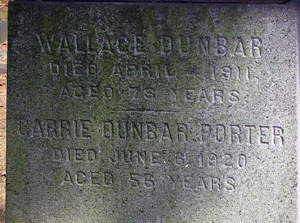
DUNBAR, WALLACE (1834-1911). Private, 127th New York Infantry, Company I. A New York City native, he enlisted there as a private on October 28, 1864, and mustered into the 127th New York on that date. His muster roll indicates that Dunbar was a clerk who was 5′ 4″ tall with hazel eyes, red hair and a fair complexion. He was on special duty at Post Headquarters from March 13, 1865, and mustered out May 31, 1865, at Charleston, South Carolina, as per Special Order 226 of the War Department.
He is listed in the 1879 Brooklyn Directory as in the ocher (paint-mixing) business and in the 1882-1883, 1884-1885, and 1885-1886 New York City Directories as being in the paint business at 99 Maiden Lane. At the time of the 1889-1890 New York City Directory, his business was located at 84 Liberty Street and he was living at 148 West 13th Street. The 1891 and 1894 New York City Directories identify Dunbar as being in the paint and ocher business; by 1890, he had moved his business back to Maiden Lane. According to the censuses of 1900 and 1910, he was a merchant living in Hackensack, New Jersey. In 1904, his application for an invalid pension was approved under certificate 1,098910. He last lived at 28 Maple Avenue in Hackensack, New Jersey. Shortly after his death in 1911, Carrie Dunbar applied for and received a widow’s pension, certificate 724,014. Section 171, lot 11219, grave 3.